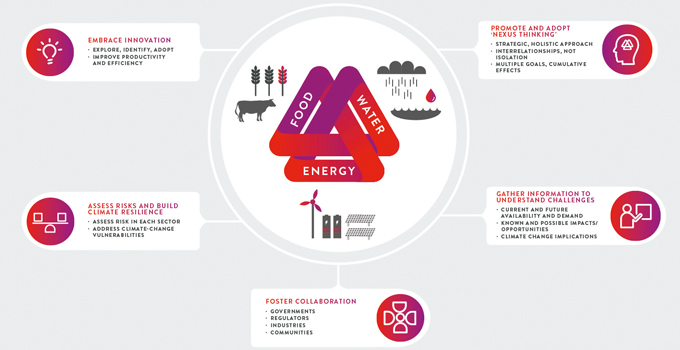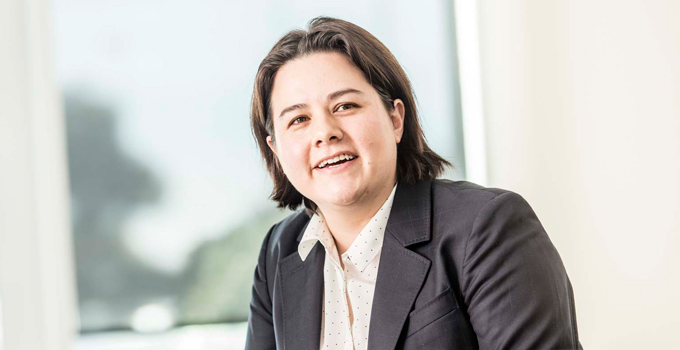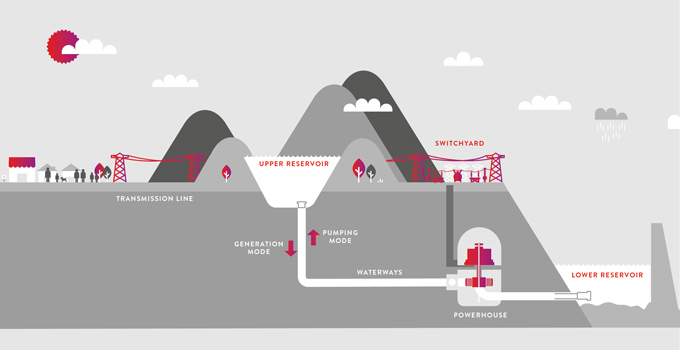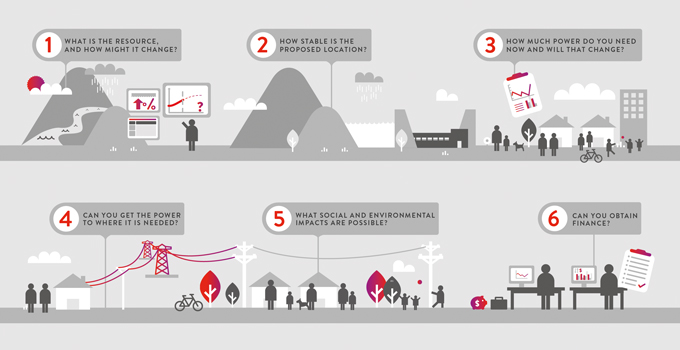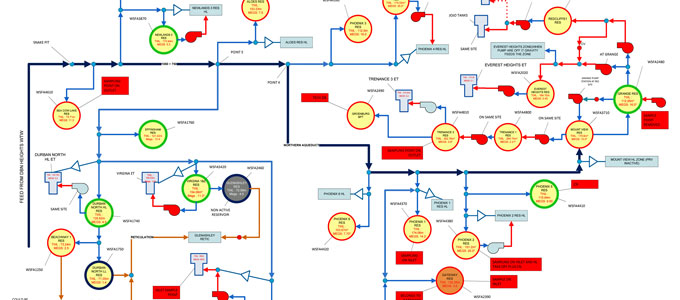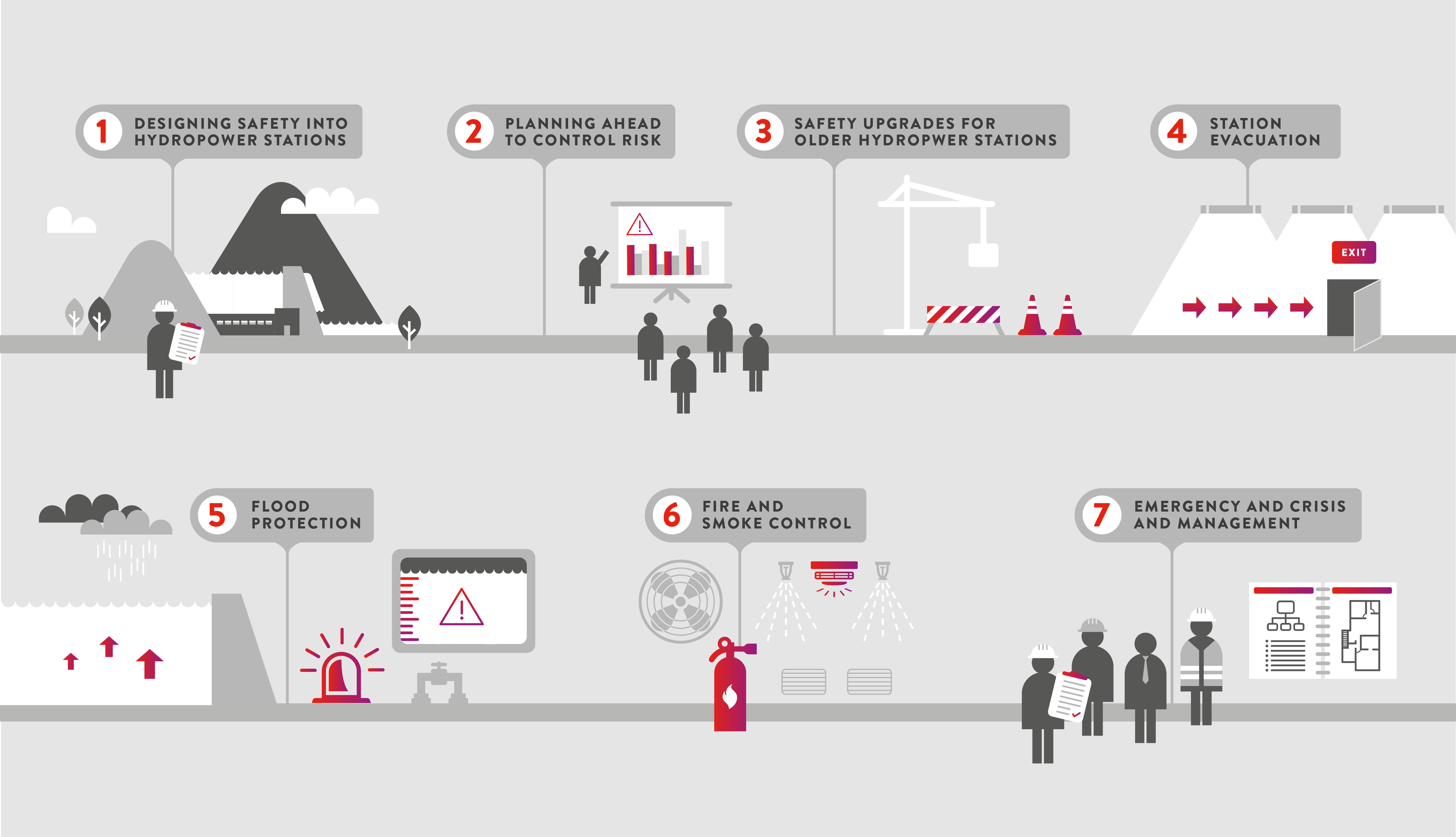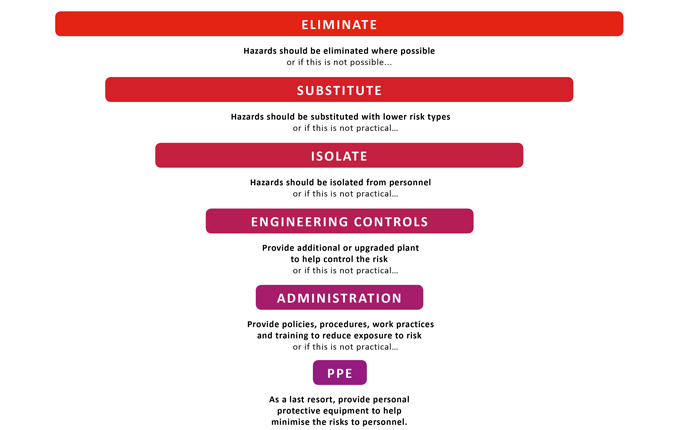Identifying Australia’s best sites for pumped hydro development
There are many thousands of potential sites for pumped hydro energy storage developments across Australia, but how can a developer filter these down to the best few?
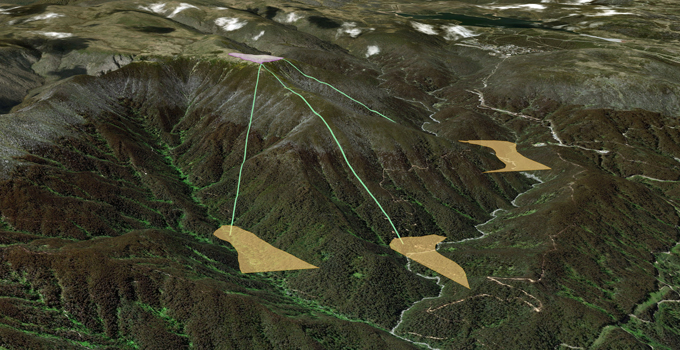
As Australia’s energy market progressively transitions from ageing thermal generation to increasing amounts of wind and solar, there are ample chances to explore and develop the energy storage solutions needed to mitigate the challenges that may come with the introduction of more renewables into the energy market.
With increased intermittent renewables, we will require more storage to smooth out the variability of weather-dependent generation so that energy is available on demand. As well, we will need storage that provides the inertia, voltage and frequency control required for a stable, reliable grid.
The key to successfully embracing these energy storage opportunities will lie in identifying the right mix of technology, capacity and site; however, pinpointing potentially viable projects is complex. A theoretical or academic approach won’t be enough to ensure a future project’s success in the real world.
Pumped hydro is a highly efficient, longer-duration solution with a proven track record, and its future is bright as Australia seeks cost-effective, reliable options to make intermittent renewables ‘dispatchable’.
There are thousands of potential pumped hydro sites across Australia. This means that developers and investors need smart methods of filtering to reduce the many possibilities to just a few ideal sites.
A pumped hydro project is a major capital investment. Getting site selection right is the foundation for success, as it will determine the likelihood of achieving a design that is both technically and commercially feasible with the right mix of capacity and costs.
Pumped Hydro Atlas of Australia offers a head start in site selection
Entura has produced a practical atlas of pumped hydro energy storage opportunities to support development of dispatchable renewable energy generation across Australia’s National Electricity Market (NEM).
Through an exhaustive process, the atlas filtered many thousands of potential sites down to the best 20 around Australia. It is already being used by leading renewable energy company Hydro Tasmania to shortlist potential pumped hydro sites for the ‘Battery of the Nation’ initiative (a major Tasmanian initiative looking at how Tasmania could deliver more clean, reliable and cost competitive energy to Australia’s NEM). Identification of promising pumped hydro sites through the atlas also offers opportunities for developers in states such as South Australia and Queensland, which have set ambitious renewables targets and must maintain energy security.
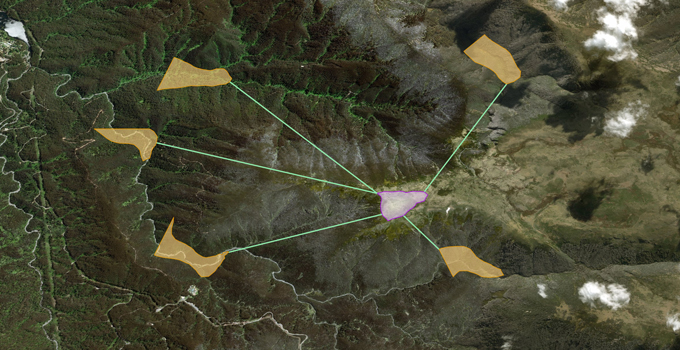
Entura’s Pumped Hydro Atlas of Australia takes into account far more than the basics of identifying ideal topography and a source of water. It also accounts for other practical factors that can make or break a project: such as proximity to and location within the transmission network, land-use constraints and environmental risks, and the practicalities and costs of construction and ongoing operation. This makes it a real-world, relevant resource identifying the best sites for pumped storage projects across the NEM.
Developing the Pumped Hydro Atlas of Australia
Originally commissioned by Hydro Tasmania, the Pumped Hydro Atlas of Australia was completed in October 2017. The journey began with a literature review, appraising previous studies. This informed the development of a set of rules, assumptions and algorithms for a GIS-based study of different reservoir types and pairing mechanisms, which were tested on pilot sites.
Using these algorithms, more than 200 000 pairing reservoirs were identified across the NEM states (Queensland, New South Wales, Victoria, Tasmania, South Australia and the Australian Capital Territory). State-based heat maps of potential sites for pumped hydro development were prepared, along with a summary of all key characteristics for each pairing reservoir set, such as installed capacity, energy storage, distance from the nearest substation, gross head, approximate headloss in the waterways, and active reservoir volume.
A subsequent stage of refinement prioritised high-potential sites in some states. This process took into account greater practical detail, such as costings, practical engineering aspects, environmental approvals and risks, realistic high-level arrangements, proximity to other generators, and characteristics of hydrology and energy storage. This stage identified more than 5000 unique potential sites, which were then further refined with a set of rules to select the best pairing reservoir at each site. The approximately 5000 sites were reduced to approximately 500 of the most attractive options: those with an average head of more than 300 m with relatively short distances between the reservoirs.
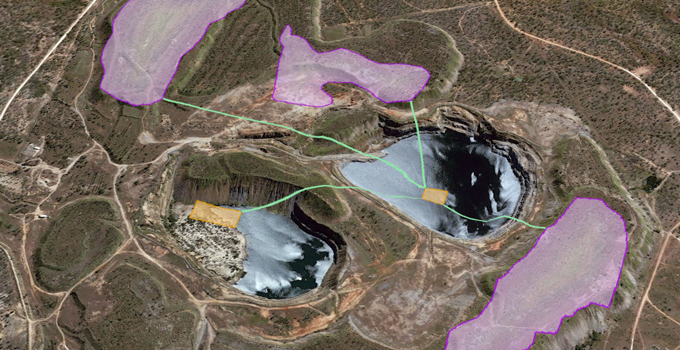
This exhaustive refining process ultimately resulted in a shortlist of twenty promising sites across different states, with a desktop review of geology, high-level engineering arrangements, and approvals requirements. For each site a map was prepared including locality, land use, planning zones, and key characteristics of the potential pumped hydro project.
The Pumped Hydro Atlas of Australia is an example of how applied hydropower engineering can be used to create practical outputs, which are ready to be applied in the real world. Overlaying the outputs of this atlas with any new wind and solar development across the NEM could result in opportunities to invest in dispatchable renewable energy generation hubs capable of replacing thermal generation assets as they retire.
Pumped hydro energy storage will no doubt play a major role in the development and expansion of networks powered by renewable energy – in Australia and around the world. As Australia’s electricity mix evolves, so will the economics of storage. While forecasting revenue for storage projects in the Australian electricity market is still somewhat uncertain, there are many opportunities in both the existing and emerging markets to guarantee project revenues to a level sufficient to satisfy a lender’s requirements. The opportunity for investors seeking a head start in this emerging market is now.
If you would like to discuss how Entura can help you with your pumped hydro or renewable energy project, please contact Richard Herweynen on +61 429 705 127 or Phillip Ellerton on +61 439 010 172.
MORE THOUGHT LEADERSHIP ARTICLES
Dispatchable renewables: a contradiction in terms?
As Australia replaces retiring coal generation with renewables, can we achieve an energy future that is affordable and sustainable as well as reliable?
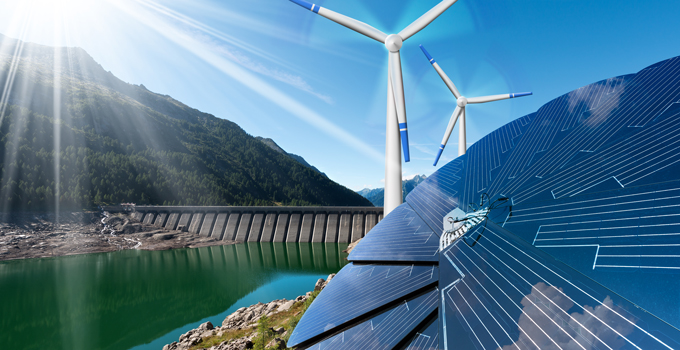
The role of renewable energy in achieving affordability and sustainability is clear. As coal-fired power stations approach retirement in Australia, renewable generation from wind and solar PV appear to be the most cost-effective options for new energy generation. Wind and solar power now offer the lowest cost of energy, have low ongoing operational costs, and emit the least greenhouse gases across their lifecycle – and therefore hold the greatest potential for rapid decarbonisation of the energy sector.
But what about achieving the third element in what has been termed the ‘energy trilemma’: reliability?
Replacing coal-fired power stations with wind and solar PV is not a like-for-like swap in terms of availability of power when it is needed by consumers. Coal-fired power stations produce firm baseload power, but generation from renewable resources varies due to the availability of the natural resource. Wind and solar PV power vary according to the weather and the time of day, and even if we consider new hydropower opportunities, most of these are small ‘run-of-river’ systems, the output of which varies with rainfall and the inflows to rivers.
Yes, these renewables certainly produce energy, but is the power produced when it is needed?
The variability in power from renewables makes matching supply and demand a challenge. This challenge increases as more renewables enter the market. With moderate amounts of renewables, it is still possible to maintain system reliability through clever solutions – in particular, targeted grid support designed through careful planning and study of generation profiles, and supported by solid communications, control, power systems studies and forecasting. However, there is a limit to such approaches, and ultimately Australia will need ‘dispatchable renewables’ in the energy mix to achieve all the elements of the energy trilemma – in other words, renewable generation that is available whenever consumers require it. The time to start planning for this transition is now.
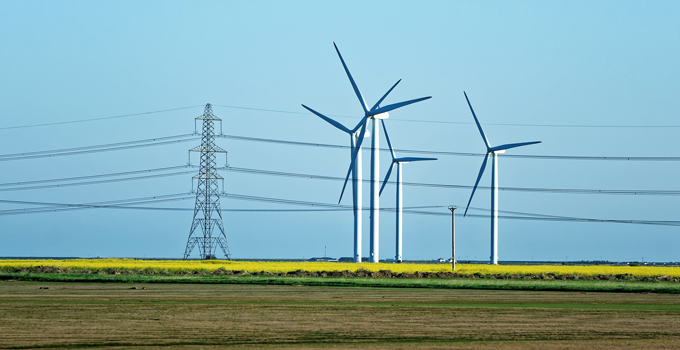
For generation to be dispatchable it needs to be available at the request of power grid operators or the plant owner according to the needs of the market. Dispatchable generators can be turned on or off, or can adjust their power output according to market need. If a generator is dispatchable it can be used to match load, meet peak demands, or fill the gap if another generator suddenly goes offline. Dispatchable generation is very valuable to the market because it can be used to match the profile of energy demand.
Effectively, baseload fossil fuel generation can be replaced by the combination of variable renewables, dispatchable renewables, smart high-voltage network support and planning to ensure sufficient transmission capacity, and change in use of existing hydropower.
How can we make variable renewables ‘dispatchable’?
The concept of dispatchable renewables seems almost contradictory: how can something generated from an inherently variable resource be dispatchable? There are two parts to this: the first is to look at how well different wind and solar PV sites naturally work together to firm supply (i.e. how likely it is that dips in one source are filled by peaks in another). Once this is understood, we need to consider how much storage is required to manage residual variability. Storage is critical here as it provides flexibility to store excess or low-value energy for times when it is really in demand.
When patterns of renewable generation are highly correlated (in other words, the timing of generation is very similar), more storage is required. For example, if the east coast of Australia develops a very high proportion of solar PV generation capacity, then all of these will be generating within about two hours of each other during the day (because of similar sunrise and sunset times across this region), and not at night. To fully utilise this energy, much of it would need to be made ‘dispatchable’ by adding substantial storage for the night-time hours, or we would need to firm the supply using another generation source, such as a gas turbine. But with a suitable proportion of wind in the mix (and stronger interconnectors to solar generation from other regions), the same dispatchability can be achieved with a more moderate amount of storage. This example demonstrates the importance of achieving a mix of renewable generators to meet the goal of dispatchability.
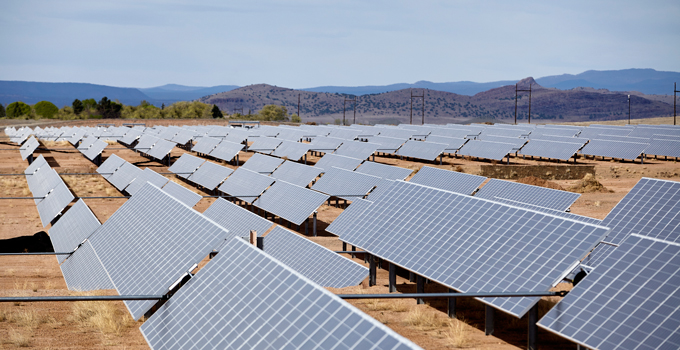
Various studies of generation in the NEM over time have demonstrated that wind and solar generation are not highly correlated. These studies have shown that even with low to moderate correlation, when considered over a large geographical area, a combination of such generators reduces variability and increases reliability of supply. Understanding this effect enables appropriate sizing of storage to create a dispatchable renewable portfolio with maximum value. There will always be some times when multiple generators produce near maximums, as well as some times when both wind and solar produce near minimums; these occasions are not common, but could have significant consequences. This is a risk that needs to be managed by the system.
The amount of firm capacity can be increased by over-installing generation, and curtailing its output when there is too much generation. However, there are still those infrequent periods when multiple generators are at their minimum and parts of the grid need extra support. Having this support available during these rare occasions will be critical to managing risk and maintaining reliable supply.
This indicates that the mixture of different renewables won’t take us all the way to the goal of achieving ‘dispatchable renewables’; storage remains a critical ingredient.
What’s the future for energy storage?
The media is awash with reports of new energy storage options. It is important to recognise, though, that different types of storage solutions vary widely in their ability to discharge power over different time frames. Therefore one type of storage will not necessarily deliver the same solution as another type of storage. Understanding this is critical to the concept of dispatchable renewables.

The power and duration of the storage are the two key variables in determining the most suitable solution. Low-power, short-term storage is currently more cost-effective using batteries, but longer periods and larger power requirements are likely to rely on bigger storage options, such as pumped hydro energy storage and traditional hydropower.
With individual wind and solar plants pushing 1 GW, pumped hydro and modified traditional hydropower solutions need to be considered. Smoothing out the daily variability in renewables can be achieved effectively through pumped hydro, but multi-day storage to supplement periods of extreme events of both low wind and low solar will require traditional hydropower with very large reservoirs.
In the long run, short-term storage will not be sufficient alone to achieve the aim of ‘dispatchable renewables’. Achieving full dispatchability of combined wind and solar PV power will depend on utilising pumped hydro storage and existing hydropower storages to their full potential.
When will we need dispatchable renewables?
The question of when we’ll need dispatchable renewables is complex. It’s driven by a combination of commercial, regulatory and technical considerations as well as changing customer behaviour (all of which are in motion).
The short answer is now.
There are already isolated opportunities in which dispatchable renewables offer distinct advantages, and where the business case may stack up. With increasing wind and solar PV developments in the network without dispatchable capability, such opportunities will only expand. However, the lead time required to include large-scale storage in these ‘dispatchable renewables’ projects means that planning must begin well in advance.
If you would like to discuss how Entura can help you explore potential opportunities for dispatchable renewables, please contact Phillip Ellerton on +61 439 010 172, Richard Herweynen on +61 3 6245 4130 or Chris Blanksby on +61 408 536 625.
About the authors
Richard Herweynen is Entura’s Technical Director, Water. Richard has three decades of experience in dam and hydropower engineering, and has worked throughout the Indo-Pacific region on both dam and hydropower projects, covering all aspects including investigations, feasibility studies, detailed design, construction liaison, operation and maintenance and risk assessment for both new and existing projects. Richard has been part of a number of recent expert review panels for major water projects. He participated in the ANCOLD working group for concrete gravity dams and is the Chairman of the ICOLD technical committee on engineering activities in the planning process for water resources projects. Richard has won many engineering excellence and innovation awards (including Engineers Australia’s Professional Engineer of the Year 2012 – Tasmanian Division), and has published more than 30 technical papers on dam engineering.
Dr Chris Blanksby is a Specialist Renewable Energy Engineer at Entura, and Entura’s lead solar energy specialist. He has undertaken and published research on the solar resource in Australia, and has led several due diligence and owner’s engineer projects for wind, solar and microgrid projects in Australia, the Pacific and Asia.
MORE THOUGHT LEADERSHIP ARTICLES
Maximising the benefits of GIS for better business decisions
‘Location, location, location!’ It’s a familiar catch-phrase in the real estate industry, but it’s just as relevant in the power and water sector. Wherever there’s location-related data, a geographic information system will guide better business decisions.
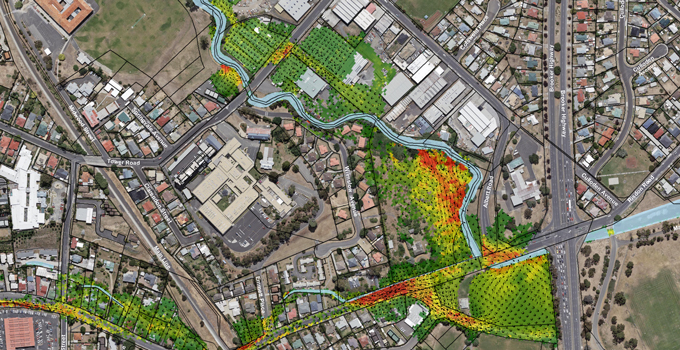
Mobile devices and apps are increasingly using location-based data collected via satellites, drones, LIDAR and other rapidly developing sensing and data capture technologies. With these advances, we are able to find relevant information more quickly and draw on that information to make informed decisions. We’re seeing this proliferate in everyday life through apps that help us navigate, find services and products, and make decisions ranging from the trivial to the profound.
Developers and managers of power and water infrastructure projects who embrace GIS (geographic information systems) stand to gain benefits on an even greater scale. Gathering high-quality spatial information and analysing it to guide business decisions will certainly improve productivity and the bottom line.
Better decisions are the necessary foundation for increased revenue, lower costs, greater efficiency and productivity, and reduced risks. So, if the technology is available and there’s so much to gain, why isn’t GIS being as widely used in the power and water sector as it could be? What may be holding businesses back from fully embracing this powerful and dynamic technology?
Do we really need to use GIS for this project?
All power and water projects involve location – from finding an optimum site for your project, to analysing combinations of spatial data to make the best management decisions or to predict events. Whenever you ask a ‘where?’ question, GIS can help. Where is the asset best located? Where are the constraints or hazards? Where are the reports of previous work done in this area? Where are the customers or opportunities?
In other words, rather than asking whether GIS is needed on a project, consider making GIS a default for every project. The real question should be “how can we maximise the benefits of using spatial data and GIS on this project?” GIS can offer business benefits far beyond the most commonly understood use: making a map.
Data capture in the field can now be streamlined – gone are the days of capturing field data with pen and paper. Users can now collect data on mobile devices, sync to databases while in the field, share data, and generate their own maps, queries and reports. Embracing these advances will save time and enable faster and better decisions.
As well as providing valuable business insights, spatial analysis and location intelligence can greatly improve communication and knowledge sharing – within project teams, with the broader business, and with the community and stakeholders – via tools such as web maps and apps, visual analysis and 3D modelling.
One of the most important applications is the simultaneous analysis of different spatial datasets to provide the best solutions or choices between alternative options, locations, objects and so on. This process is better known as multi-criteria analysis (MCA) and it can be used for many applications.
For example, MCA can be used to find the optimum site for your project taking into account a range of values such as local geology, threatened species, resource availability, land use and terrain, planning restrictions, communities and demographics. Using MCA, you can establish areas of best fit for your project based on thematic overviews of areas of constraint, cost of construction, access and transportation routes.
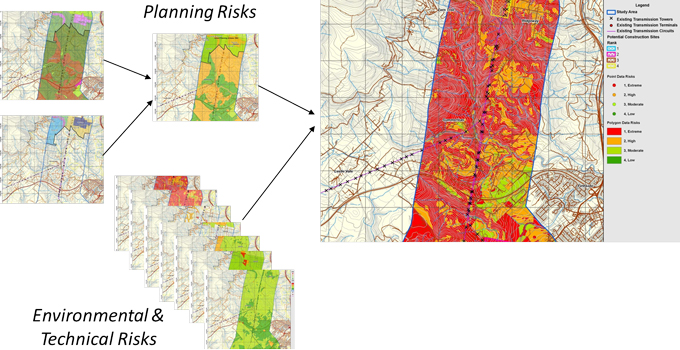
Risks such as bushfire, weeds, threatened species, pollution sources, landslides and erosion can also be more easily and fully understood, supporting your ongoing site management of such issues.
GIS also links with document management, asset management, business intelligence and enterprise resource planning (ERP) systems. It can act as a portal, creating a central point of easy access, pulling together information and making it available on one of the simplest forms to interpret – a map.
Of course GIS is not the answer to everything, and it is not a standalone platform. However, there’s much it can offer across many different business activities, working together with other business systems.
What about the costs?
The return on investment of using GIS should be positive if it is used appropriately. For site selection of power and water projects, using GIS is a no-brainer. For example, using GIS to find the best site for a wind farm – locating the best winds, minimal constraints, good proximity to existing infrastructure and appropriate land use – will obviously result in vastly greater returns than siting the wind farm in an inferior location.
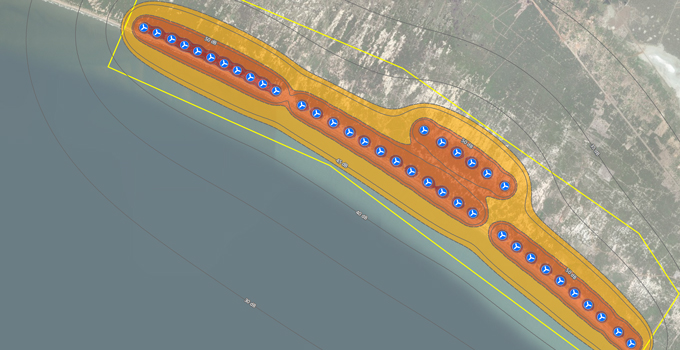
Some examples may be less immediately apparent, but equally valuable – for example, using GIS to increase efficiencies in everyday workflows. If your workers are taking an extra half hour every time they need to find previous work completed in an area, this time can add up quickly. Or perhaps they can’t find previous information, so work is re-done unnecessarily. These costs will keep adding up. Instead you could use a GIS web map to locate all your previous reports and projects, so that a simple click on a map finds the files and saves hours (if not days) of time.
Do we need specialist software or skillsets?
With most things, you do need specialised skillsets and software to get good results, and of course bad data in equals bad data out. Users of GIS do need to understand and assess the spatial data needs in each application.
You could undertake some GIS work yourself using free or open-source software. However, be aware of the risks of using data or tools that aren’t fit for purpose. Just because you know how to use Microsoft Word, doesn’t mean you could write a detailed report outside your area of expertise!
We have seen cases where coarse-resolution data has been used to infer finer project details and costs, resulting in poor decisions. We have also seen inexperienced operators make invalid assumptions. To get the best results, you need to be sure that you’re using the technology wisely.
If you are engaging a power, water or environmental consultant on a project, they are likely to have access to GIS capability; however, GIS is still often underutilised. When deciding who to engage on your project, ask your consultant how they will maximise the benefits of GIS to produce better outcomes for your project.
To discuss how Entura can help you harness the potential of GIS to improve your power and water project decisions and outcomes, contact Stephen Thomas on +61 3 6245 4511, Patrick Pease or Phillip Ellerton on +61 439 010 172.
About the authors
Stephen Thomas is Team Leader and Senior Technical Officer with Entura, specialising in geographic information systems, 3D visualisation and CAD software. Steve has over twenty-six years of technical experience and specialises in environmental assessments and approvals for engineering surveys and property. He has created 3D models and animations of proposed developments including wind farms, urban landscapes and city frameworks. Steve’s work on the Hobart Waterfront 3D model won an international award in geospatial modelling.
MORE THOUGHT LEADERSHIP ARTICLES
Is there an economic case for pumped hydro?
As the proportion of renewable energy in the grid continues to grow, pumped hydro energy storage offers a solution for greater reliability. But can the business case for storage stack up?
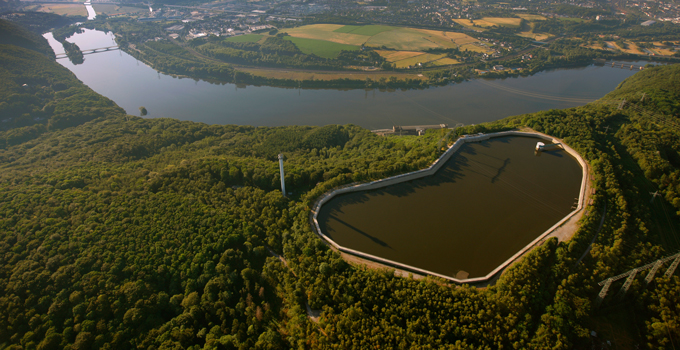
The future is bright for pumped hydro in Australia, and for storage in general. However, no energy solution can exist outside of the real and competitive pressures of the market. Technical viability and environmental benefits won’t be enough to get projects over the line if they can’t demonstrate their financial soundness.
So how can pumped hydro generate sufficient revenue to be attractive to investors? And will that revenue continue to be predictable enough over the longer term?
No doubt there are opportunities, but developers may need to explore a range of different revenue sources in both existing and emerging markets since the arbitrage opportunities of the past may not be present in the future.
Where to for energy arbitrage?
The traditional revenue source for pumped hydro is arbitrage – in other words, making the most of generating when the spot price is high, and pumping when the spot price is low. But this relies on a certain level of predictable variability in the electricity market, and for that variability to continue into the future.
The upcoming retirement of several coal-fired power stations and the continued investment in renewables are likely to cement a market in which variability in power generation and the consequent volatility in energy prices are the norm.
Forecasting revenue – no easy task
Financing an energy project requires a firm revenue forecast. Lenders may consider ‘firm’ to be a 90% confidence limit, which means the developer must demonstrate that the project can generate a certain amount of revenue 90% of the time, or, say, in 9 out of 10 years. This means that a robust and reliable forecast of project utilisation must be made.
Forecasting revenue for an asset with a lifecycle of up to 100 years requires detailed modelling of a wide range of factors influencing the electricity market, including supply (factoring in new entrants, storage, retirements and developments in the thermal sector, etc.), demand (including changes in industrial load, impacts of electric vehicles, etc.), fuel prices, government policies, and bidding strategies for large-scale wind and solar projects.
A business case for pumped hydro relies on all the assumptions that go into regular power plant financial modelling and adds the complexity of arbitrage.
A further complication is the impact on market prices of the presence of the developer’s own project. In other words, how will the proposed project influence the market in which it participates?
For a storage project, the influence is likely to be both an increase in low prices and a decrease in high prices. If the market is robust enough and the proposed project is relatively small, the influence could be minor. However, a very large project is likely to influence the market to such an extent that the utilisation of the project may significantly reduce, which would reduce project returns.
Building a bankable business case
How can the confidence in a forecast be increased enough for a lender to commit funding to a project, given that variance of any one of these assumptions could disrupt the revenue streams for the project? While the transition to a renewables-dominated market continues, it may be that lenders need assurance that other revenue streams exist to reduce the project risk.
Price insurance
High price events in the electricity market will certainly continue to occur, but it’s impossible to predict their timing. Energy storage projects can provide insurance to exposed customers (such as retailers and major industrial customers) through a cap contract in a similar way to gas turbines and other peaking plant. In practice, this may mean that the storage project rarely operates unless the price regularly exceeds the cap.
Network support services
Storage projects have the ability to provide network support services such as frequency control, inertia and fault level control. These services have increasing value in a grid with significant amounts of non-synchronous generation. At this stage, the markets for these network support services are very shallow and competition is increasing. However, the need for such services is likely to increase to the point where more significant markets are required.
Renewable firming
Government energy policy continues to be fluid, yet under the proposed National Energy Guarantee it is possible that there will be value in providing firming services – in other words, pairing ‘dispatchable’ generators (such as storage projects or open-cycle gas turbines) with ‘intermittent’ renewable sources of energy to improve reliability.
‘Behind the meter’ generation
Storage projects are exposed to market prices during both modes of operation (pumping/charging and generating). If, however, there was an option to pump/charge for ‘free’, wouldn’t that reduce the risk?
Genex Power’s world-first Kidston ‘K2 Project’ will pair a 250 MW pumped hydro project with a 270 MW solar PV farm. During the day, solar energy can be used to power the pumps in the pumped storage project. The pumped hydro project will then generate into the evening (and morning) peak. If the upper storage is ‘charged’ during the day, the K2 solar project can generate into the Queensland market and realise the benefits of large-scale generation certificates (LGCs). Of course, this arrangement relies on sufficiently high prices during peaks to recover the additional cost of the solar farm, transmission losses and any LGC liability.
As our electricity mix evolves, so will the economics of storage. While forecasting revenue for storage projects in the Australian electricity market is still an uncertain business, there are many opportunities in both the existing and emerging markets to guarantee project revenues to a level sufficient to satisfy a lender’s requirements.
If you would like to discuss how Entura* can help you with your pumped hydro project, please contact Nick West on +61 408 952 315 or Donald Vaughan on +61 3 6245 4279.
*Entura provides technical advisory services to prospective investors and developers. Financial advisory is not part of our suite of services, however, we partner with financial advisory firms supporting our clients. Entura is the consulting arm of Hydro Tasmania. Hydro Tasmania is licensed (AFSL 279796) to provide general financial product advice. Hydro Tasmania is not licensed to provide nor will it provide advice which considers a person’s objectives, financial situation and needs and you must therefore rely on your own assessment or seek your own independent advice in respect of decisions in relation to any financial product offered.
About the authors
Nick West is a civil engineer at Entura with more than 16 years of experience, primarily in hydraulics and hydropower. Nick’s skills range from the technical analysis of the layout of hydropower projects to the preparation of contractual project documents and computational hydraulic modelling. Nick was a key team member of the Kidston Pumped Storage Project Technical Feasibility Study.
Donald Vaughan is Entura’s Technical Director, Power. He has more than 25 years of experience providing advice on regulatory and technical requirements for generators, substations and transmission systems. Donald specialises in the performance of power systems. His experience with generating units, governors and excitation systems provides a helpful perspective on how the physical electrical network behaves and how it can support the transition to a high renewables environment.
MORE THOUGHT LEADERSHIP ARTICLES
‘Nexus thinking’ for a secure and sustainable future
As the global population continues to grow, how can utilities and water managers balance the increasing and interrelated pressures on water, energy and food?
The complex triangular relationship among these three pillars of life is known as the ‘water-energy-food nexus’. It’s an intricate puzzle, in which the increased demand for each limited resource can significantly affect the security of all three.
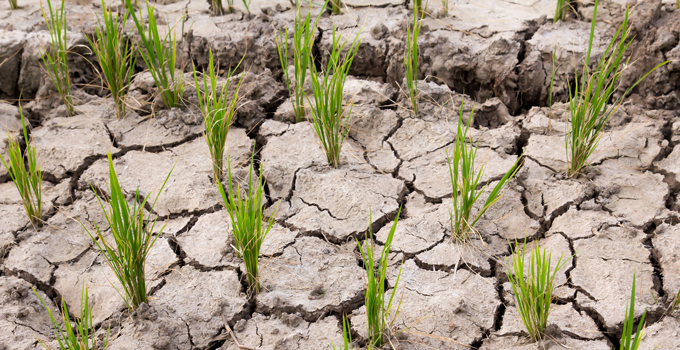
According to the International Renewable Energy Agency, over the next few decades, global growth in population, economic development and urbanisation are expected to raise demands for water and food by 50% and to double the demand for energy. Water, energy and food are all fundamental to growing economies, alleviating poverty, and improving health and educational opportunities worldwide. To create a sustainable future, we must seek holistic and integrated solutions for water, energy and food challenges , as well as the appropriate balances amongst them.
With water being so central to food security and energy security, the potential impacts of climate change on water resources are of increasing concern. Climate change is likely to raise average temperatures in many locations, change the patterns of rainfall and inflows, and affect the frequency and severity of extreme weather events such as drought or floods – all of which increase vulnerabilities for water, food and energy resources already under strain.
A nexus approach
Our experiences throughout Australia and the Asia-Pacific region demonstrate that there is no single solution to the challenges of this nexus. It is really about a way of thinking and approaching decisions rather than a fixed solution or response.
These five broad considerations are likely to contribute to improved nexus outcomes.
Promoting and adopting ‘nexus thinking’
‘Nexus thinking’ means considering and understanding water, food and energy and their interrelationships, rather than viewing any in isolation. It is a strategic and holistic style of thinking that considers long-term implications across the nexus, weighing up and balancing social, economic and environmental goals.
Nexus thinking looks at the big picture: considering the whole catchment or river basin, trans-boundary issues, multiple uses (existing and future) and cumulative effects. It also involves thinking across agencies and organisations where responsibilities for water, food and energy lie.
Gathering the best information to understand nexus challenges
Responses to nexus challenges are more likely to be effective and sustainable if they are based on an informed and risk-based understanding of present conditions and possible future scenarios (taking into account interrelationships across sectors and regions).
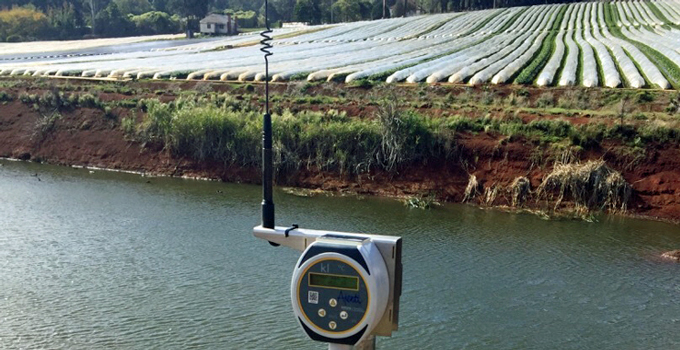
This means that decision-makers need to understand the resource availability, current demand, known impacts, development opportunities and potential climate change implications in a given situation. They also need to understand what stakeholders and communities need, and explore opportunities for additional benefits to be realised.
Fostering collaboration among government, regulators, industry and communities
All stakeholders can benefit from collaborative and cooperative responses to the nexus and to stewardship of resources. The potential wins include better economic outcomes, improved reputation, reduced risks, avoided conflict, and opportunities for greater synergies. Reaping the benefits will require partnerships and cooperation among food-producing industries, the energy sector and other water-dependent industries, as well as local communities.
It’s also essential that governments, regulators and communities are closely involved in all decisions and developments affecting water, energy and food resources so that different priorities and opportunities can be considered. At a policy and regulatory level, cohesive and stable governance, policy and strategies are needed to facilitate and encourage the right collaboration that brings benefits to all stakeholders.
Assessing risks and building climate resilience
The water-energy-food nexus brings risks as well as opportunities . Interrelationships between water, energy and food, and the threats posed by climate change, should be built into risk assessments in each sector. State-of-the-art data collection, modelling and forecasting can assist businesses, governments and communities to better understand and mitigate their specific climate-related vulnerabilities and take action towards building greater resilience to future climate change impacts.
Innovating
In the water, energy and food sectors, technological and other innovations continue to expand the opportunities for improving productivity and resource efficiency for long-term sustainability of pressured resources.
Nexus challenges may also bring opportunities
The nexus is not only a dynamic of ongoing resource competition. Integrated planning offers opportunities for potential synergies and benefits among sectors.
For example, in the hydropower sector, electricity generation is intrinsically linked with water availability. The need for water for irrigation to produce food and to drive agricultural productivity may compete with water requirements for hydropower generation. Hydropower’s water needs may also compete with the requirements of urban water supply, other industries and environmental and social needs.
However, renewable energy resources such as hydropower can also offer benefits to the water and food sectors through improving water resource management, providing multipurpose storages, contributing to the development of water supply infrastructure and, of course, generating the electricity critical to food-producing industries.
Many existing hydropower storages, both in Australia and internationally, were developed solely to supply water for energy generation. However, over time and with increasing competition for water and food, the storages have become multipurpose, often providing water for domestic supply, irrigation, and commercial and recreational fisheries.
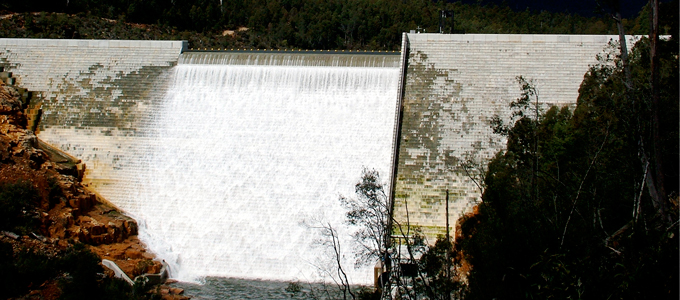
In South-East Asia, some hydropower storages are now more important as a source of irrigation water for downstream communities than for the energy they generate. By providing water to the downstream communities, irrigation and food production has increased significantly since development of the schemes, lifting the economic development of the region and providing benefits across the community.
Integrating other renewable energies into water supply, irrigation and food production can also provide mutual benefits, such as utilising renewable energy for pumping on farms or for water desalination. Incorporating small hydropower into existing water infrastructure can improve efficiencies and create new low-carbon income streams to support effective water supply delivery. Another innovation of attaching solar PV to covers on water storages provides electricity for pumping while minimising evaporation and maximising water availability.
Whether at small-scale single utility or local geographic area or at a national or multinational scale, nexus thinking can bring about mutual benefits for energy, water and food outcomes .
If you would like to find out more about how Entura can help you develop a sustainable water or energy solution or respond to the challenges of the water-energy-food nexus, contact Dr Eleni Taylor-Wood on +61 3 6245 4582.
About the authors
Dr Eleni Taylor-Wood is Entura’s Principal Consultant, Environmental and Social Science. Eleni has more than 20 years’ experience successfully managing large-scale, complex projects that run over several years, as well as providing expert advice and independent review for a range of infrastructure and planning projects. She has worked on projects around the world including in Australia, Mozambique, South Africa, Iceland, Colombia, India, Malaysia, Mekong, Solomon Islands, Fiji and Papua New Guinea. Her experience covers a vast gamut of studies including: environmental and social impact assessment and management; strategic management of wetlands and waterway; feasibility and approvals for new hydropower projects, environmental flow determination and assessment, and sustainability assessments. Eleni is currently one of eleven Accredited Assessors under the Hydropower Sustainability Assessment Protocol worldwide.
MORE THOUGHT LEADERSHIP ARTICLES
Batteries vs pumped hydro – are they sustainable?
A sustainable grid needs sustainable energy sources. While there’s no doubt that it makes sense to store renewable energy, whether in batteries or in a pumped hydro scheme, just how sustainable are these technologies?

As we move rapidly towards ever-greater levels of wind and solar power in the network, increasing quantities of storage are needed to smooth intermittency and ensure secure supply. Pumped hydro energy storage and batteries are likely to do much of the heavy lifting in storing renewable energy and dispatching it when power demand exceeds availability or when the price is right.
We’ve previously compared the two technologies in terms of their costs, the speed with which they can be deployed, and their ability to support the grid. Here we compare their sustainability in terms of storage efficiency and capacity, safety, use of scarce resources, and impacts through all stages of their lifecycle.
Storage efficiency and capacity
For both batteries and pumped hydro, some electricity is lost when charging and discharging the stored energy. The round-trip efficiency of both technologies is usually around 75% to 80%. This level of efficiency for either technology represents a significant displacement of non-renewable generation if we assume that the stored generation would not otherwise occur.
A particular consideration for batteries is degradation. Batteries degrade as they age, which decreases the amount they can store. The expected life of the batteries that will be used for the recently announced battery storage project in South Australia is about 15 years (depending on how the batteries are operated). By the end of that time, the capacity of the batteries is expected to have dropped to less than 70% of their original capacity.
To maintain a reliable and steady capacity for storage as batteries age and degrade, large-scale battery plants will require ongoing staged installation and replacement of batteries. In comparison, the degradation of pumped storage is close to zero. With appropriate maintenance, peak output can be sustained indefinitely.
Safety
No storage solution can be considered sustainable unless it is safe. The greatest risk relating to pumped storage is dam safety. If it occurs, dam failure can affect downstream communities and the environment, with its impact potential likely to be far greater than a battery safety incident. Nevertheless, pumped hydro technology is mature, dam risks are generally well understood and managed, and the frequency of dam safety events is low.
The main safety concern for batteries is thermal runaway leading to explosions and fires. The severity of this risk will depend on how a battery project is implemented. In a modular arrangement, thermal runaway would be localised, not affecting the whole bank. However, because of the very rapid deployment of evolving battery technologies, safety standards may not be rigorously enforced.
Impacts on land and water
Pumped hydro and grid-scale battery plants may have environmental and land-use impacts. These impacts would vary depending on the sensitivity of the site selected.
A grid-scale battery facility needs a relatively small parcel of land and is likely to be able to be created very close to the energy demand or where generation occurs. Land in these areas has often already been disturbed and the new operations may have little extra environmental impact. Land and water impacts of batteries relate more to their disposal at the end of their effective life, and to the extraction of the resources to produce new batteries.
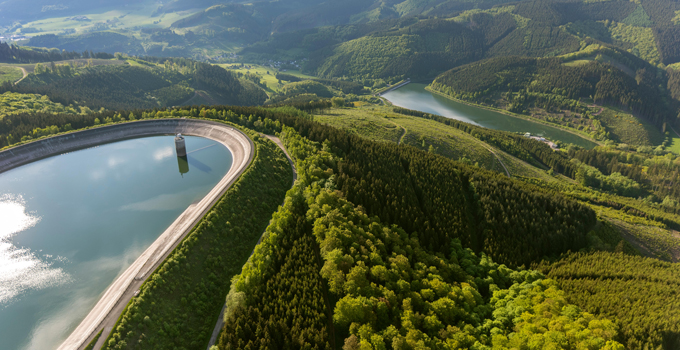
Pumped hydro requires a relatively larger parcel of land with a very particular topography, and may be far from the location of the demand. Any potential environmental impacts associated with construction and operation need to be considered and mitigated, including those immediately associated with the site, as well as downstream.
In most construction of new pumped hydro, sites are selected where impacts can be mitigated to acceptable levels, for example by using existing reservoirs, or locating ‘closed loop’ systems away from rivers. Although these arrangements will have lower overall impacts, some environmental challenges may still occur during construction when existing water is removed from the site as well as finding a source of water without impacting the environment and other users.
Environmental impacts during operation of pumped hydro are minimal. However, the ecology within the reservoirs will need to adapt to frequently changing water levels, reducing diversity in the system especially within fringing communities.
In all pumped hydro systems, water is re-used over and over again, extracting maximum value from the resource. Nevertheless, depending on the configuration of the pumped hydro project, there may be an ongoing demand for water to top up the storages to counter evaporation.
Minerals and materials
Batteries and pumped hydro require a range of different resources and materials. Lithium-ion batteries use common materials such as plastic and steel as well as chemicals and minerals such as lithium, graphite, nickel and cobalt. Although pumped hydro mainly relies on common building materials such as concrete and steel, the quantities of these materials and the construction impacts can be significant.
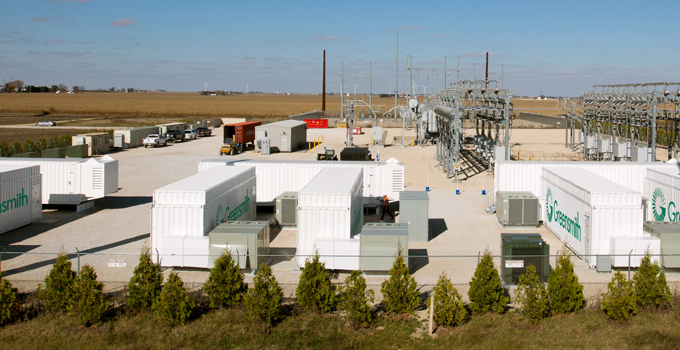
Image courtesy of Greensmith, a Wärtsilä Energy Solutions company.
Determining the ultimate sustainability of the required resources and materials for both technologies needs to take account of the full lifecycle and supply chain (mining, processing, refining and manufacturing) as well as end-of-life issues such as recycling, disposal or decommissioning.
Currently, the environmental and health impacts of mining are a significant sustainability concern for the battery industry, and impacts are likely to intensify as worldwide demand for the necessary minerals rapidly increases. Short-term availability of many of the necessary minerals for battery development, such as lithium, appears sufficient, yet security of supply could be compromised by geo-political factors, and long-term availability will depend on levels of demand.
Ultimately, the minerals used in lithium-ion batteries are finite resources, so limiting or reducing their extraction (for example, through greater recycling or substitution for another battery technology) would increase longer term sustainability.
End of life
A battery’s life depends on the technology and on frequency of charging and discharging. Once their effective life is up, the batteries must be disposed of and replaced. Disposal of batteries is a problem we’re yet to face, but as large-scale battery storage proliferates, increasing numbers of batteries will enter the global waste stream. Without careful management of disposal, what cannot be recycled may end up in landfill and may be corrosive, flammable, or could leach toxins into soil and water.
The development of cost-effective and efficient battery recycling methods is still in its infancy.
Although most of the components of batteries can be recycled to some extent, recycling is currently expensive and there is insufficient volume to encourage commercial enterprises to take on recycling the new generation of batteries. In time, improved recovery and re-use of materials will certainly increase the sustainability of battery storage, preserving virgin resources and reducing the impacts of extraction and processing.
End-of-life considerations for pumped hydro seem very distant right now due to hydropower’s longevity, but sustainable decommissioning still needs to be planned for, including managing the impacts on the downstream environment if a dam is removed and rehabilitating the reservoir area.
Lifecycle analysis
At this early stage of development of large-scale battery technology, comprehensive lifecycle analysis is limited by the diversity of battery materials and widely different scenarios of charging, battery life and recycling.
In contrast, the full lifecycle of pumped hydro is better understood due to the maturity of the technology. Pumped hydro is not without impacts, but the risks are known and generally manageable. A major advantage of pumped hydro over batteries is that the expected life of pumped hydro is more than 100 years, or effectively unlimited with appropriate maintenance.
Batteries may have a lower upfront cost than pumped hydro and be easier to approve and install; however, they are likely to require greater management over time. If a projection is made based on current information, the full lifecycle cost and impact of batteries may be greater than hydro across the long term, particularly when mining, recycling and disposal are taken into account. Yet, battery technology is likely to improve very rapidly, which would tighten the gap on pumped hydro’s current lifecycle advantage.
A greener grid
Worldwide, increased levels of renewable energy will lead to a greener grid. It is easy to recognise the sustainability benefits of using a storage solution such as pumped hydro or batteries to further enable the decarbonisation of the network through greater uptake of renewable energy. However, the storage solutions that enable more renewables must also be sustainable – not only in the use phase, but also upstream and downstream.
It is difficult to make a straightforward comparison of the sustainability credentials of pumped hydro and battery storage technologies at their very different stages of maturity. As battery technology is still evolving, its overall sustainability is still somewhat uncertain, but this will change with experience and improvements in battery life and recycling. Meanwhile, pumped hydro projects can last up to a century and associated risks are known and can be mitigated.
Either way, as we redevelop the electricity grid, we will also need a mature approach to lifecycle analysis of our storage solutions.
About the authors
Donald Vaughan is Entura’s Technical Director, Power. He has more than 25 years of experience providing advice on regulatory and technical requirements for generators, substations and transmission systems. Donald specialises in the performance of power systems. His experience with generating units, governors and excitation systems provides a helpful perspective on how the physical electrical network behaves and how it can support the transition to a high renewables environment.
Nick West is a civil engineer at Entura with 16 years of experience, primarily in hydraulics and hydropower. Nick’s skills range from the technical analysis of the layout of hydropower projects to the preparation of contractual project documents and computational hydraulic modelling. Nick was a key team member of the Kidston Pumped Storage Project Technical Feasibility Study.
MORE THOUGHT LEADERSHIP ARTICLES
Building climate resilience into operations: Hydro Tasmania’s journey
Climate change presents major risks for power and water businesses. To best prepare for the impacts of extreme or changing weather conditions, asset managers need to act now to build climate resilience into operations and ongoing risk management.
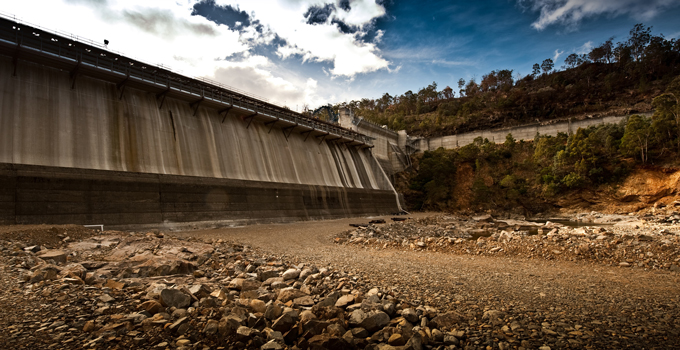
Around the world, businesses and communities face the many risks of climate change such as higher temperatures, changes in water availability and rainfall, more frequent and severe weather events. For power and water businesses, these may lead to major infrastructure damage and financial and environmental consequences.
In 2015 to 2016, these hypothetical risks became a challenging reality for Hydro Tasmania, Australia’s largest renewable energy producer and water manager. Hydro Tasmania faced unprecedented extreme weather conditions from September 2015 to June 2016 – and managed to come through the crisis while still safeguarding Tasmania’s ongoing access to high-quality, reliable water and power, and limiting environmental consequences and asset damage.
Entura supported Hydro Tasmania’s response to this major climate-related challenge through a range of earlier best-practice resilience-building measures, and significant interventions across a range of areas during the crisis itself.
What happened in 2015-2016?
Although Hydro Tasmania had experienced some variability in the past in Tasmania’s climate patterns, and despite understanding the risk of increasing future climate variability, the extreme dry conditions of September 2015 to April 2016 were unseasonal, unexpected and unprecedented. In Tasmania, summer inflows are traditionally low, but in this case, the usually dry summer was preceded by record-low spring inflows. Below-average rainfall across both spring and summer was the lowest recorded in 50 years.
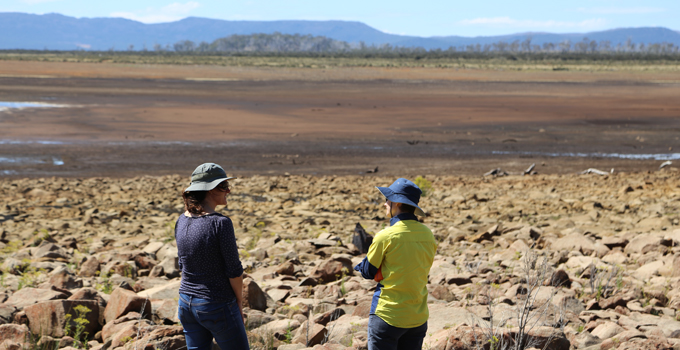
In normal operating conditions, low inflows could have been mitigated by importing power from mainland Australia across the undersea interconnector cable, Basslink, so that storages could be maintained. Yet, in another unprecedented scenario, in December 2015 the Basslink interconnector became inoperable just as summer arrived. Hydro Tasmania was now no longer connected to Australia’s national electricity market and many months remained before expected autumn/winter rains.
By late April 2016, Hydro Tasmania was experiencing its lowest storage levels ever, down to 12.5% total energy in storage, and serious environmental risks were emerging in some of its sites.
To compound the challenges, in January and February 2016 at least 70 separate fires were listed in Tasmania’s north-west, west, south-west and central highlands.
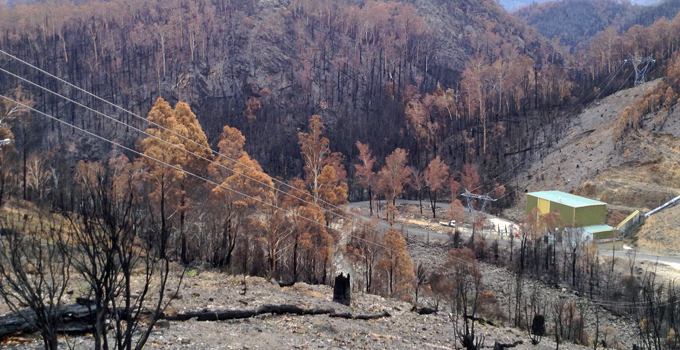
These extraordinary circumstances combined to present Hydro Tasmania with a major operational challenge. How could it keep the lights on and keep businesses operating in Tasmania while also protecting the environmental values associated with water storages and preserving the condition of its assets?
When the drought broke, conditions shifted from one extreme to another. Floods in June 2016 in northern Tasmania hit historic highs, exceeding all previous flood records in many locations. Several river-level measurement stations experienced the highest water levels on record.
How was the crisis managed?
Hydro Tasmania’s climate resilience and risk management strategies were called into action. Entura actively supported Hydro Tasmania through the energy supply challenge across a range of measures.
Generation planning and supply
To maintain adequate power supply, Hydro Tasmania drew on generation modelling and planning based on rainfall forecasts, climate model outlooks, and known and predicted electricity demand.
Voluntary reductions in major industrial loads were negotiated, and actions were taken to assess and instigate alternative generation options, such as restoring gas generation and implementing 200 MW of temporary diesel generation to bolster power generation. Entura assisted Hydro Tasmania to identify and assess feasible generation options and sites, and to progress these options through approvals and into operation.
Through these integrated and rapidly executed measures, Hydro Tasmania was able to maintain electricity supply for Tasmania without any outages for domestic users.
Environmental management and multiple water use
Another critical aspect of the successful result drew on Entura’s expertise in environmental management. Environmental impacts were monitored throughout the crisis. Lake-level risk bands were reassessed to better protect water quality and threatened species and to limit the long-term impacts on environmental values.
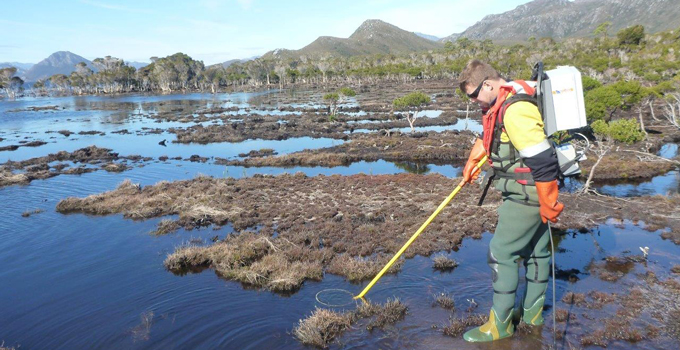
Water management also considered and mitigated impacts on other water users, such as boating, recreational fishing and water supply.
Bushfire management
The bushfires experienced across the state during the summer period did not adversely affect Tasmania’s energy security, as Bushfire Preparedness Fire Management Plans were already in place, and were activated to protect individual power stations and key assets through fuel reduction and other measures.
Dam safety and monitoring
Despite the extreme flood conditions, dams and spillways operated well within their design parameters, indicating that Hydro Tasmania’s ongoing dam monitoring and dam safety systems were robust. Safety inspections after the floods found only minor damage to non-critical elements of some dams.
During the high rainfall conditions, monitoring of dams and waterways provided alerts to downstream communities.
Road and asset management
Another consequence of the flooding was damage to some of Hydro Tasmania’s secondary assets (roads, canals) due to landslips, and the loss of some river-flow monitoring sites. Entura assisted with assessment and rectification of this damage.
Success drew on prior climate-resilience preparation
Ultimately, the example of Hydro Tasmania demonstrates climate resilience in practice. It shows how an investment in climate resilience enables a power and water business to be better prepared, more flexible and more robust in the face of a climate ‘shock’.
Hydro Tasmania’s management of the crisis required a comprehensive understanding of Tasmania’s climate and catchments. Entura’s involvement in 2007 in developing a Climate Change Response Strategy had provided a basis for this understanding, and a crucial input into identifying the risks and opportunities stemming from climate change.
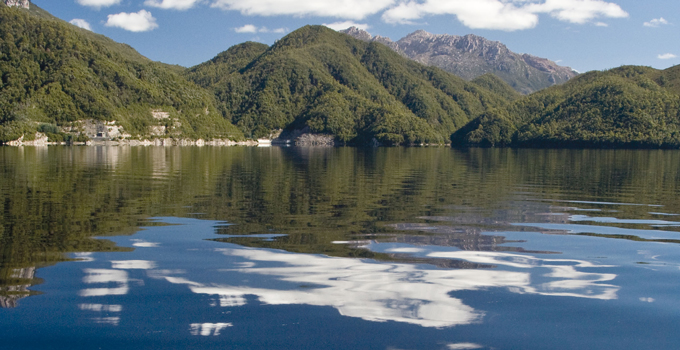
Further inputs for climate resilience came through the collaboration in 2008 to 2010 between Entura and the CSIRO (Australia’s national scientific research organisation) on the first fine-scale climate and river system modelling for Tasmania, through the Climate Futures for Tasmania and the Tasmania Sustainable Yields projects.
The results of that research were state-of-the-art regional climate modelling and hydrological models to project future catchment yields for Tasmania. The modelling indicated that under climate change Tasmania could expect gradual temperature rises, changes in rainfall patterns over coastal regions, reduced rainfall over central Tasmania, changes to run-off patterns, and changes to the frequency and severity of extreme weather events including increased rainfall intensity and floods.
This modelling was critical in enabling Hydro Tasmania to plan and balance generation and storage levels over a range of demand and inflow scenarios and to assess environmental impacts during the extended period of drought.
Another key aspect of managing the energy supply challenges through the drought involved setting up supplementary diesel generation. This drew on Entura’s expertise and extensive involvement in developing hybrid off-grid renewable energy systems.
Hydro Tasmania’s climate resilience also involved being prepared for the drought to break. Key contributions from Entura included flood forecasting and flood support systems, ongoing support of Hydro Tasmania’s dam safety and emergency planning programs, and prior involvement in upgrading dams and designing spillways to withstand predicted increases in the frequency and magnitude of floods.
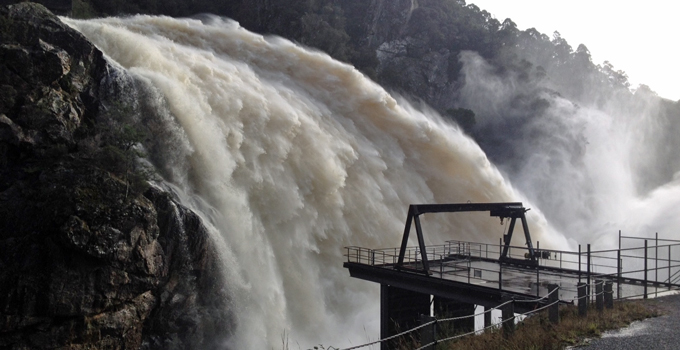
Entura also supported Hydro Tasmania’s procedures and ongoing activities to manage the secondary impacts of the fires and floods (such as damage to infrastructure), as well as the risks posed by low lake levels to social and environmental values. Entura’s environmental scientists monitored threats to aquatic flora and fauna through the 2015/16 crisis. To ensure the least likelihood of long-term or irreversible environmental damage, Hydro Tasmania’s environmental risk bands were revised.
Investing in your climate resilience
Any proactive and sustainable power or water business needs to invest in understanding the range, likelihood and consequences of the potential impacts of climate change for their current and planned systems and operations – whether for hydropower, transmission, dams, irrigation or water supply – and how to avoid or mitigate the impacts.
The more businesses understand the potential impacts of climate change and risks to their projects and operations, the better they can prepare, adapt, and build resilience to climate change impacts.
If you would like to learn more about building greater climate resilience into your project or operations, please contact Dr Eleni Taylor-Wood on +61 3 6245 4582, Phillip Ellerton on +61 439 010 172 or Shekhar Prince on +61 412 402 110.
About the authors
Tammy Chu is the Managing Director of Entura, one of the world’s most experienced specialist power and water consulting firms. She is responsible for Entura’s business strategy, performance and services to clients, and is part of Hydro Tasmania’s Leadership Group. As a civil engineer, Tammy specialised in the design and construction of mini-hydro and hydropower systems, project management, hydropower investigations, prefeasibility and feasibility studies, environmental assessments and approvals, resource investigations and resource water management. Tammy is a member of the Board of the International Hydropower Association. She was the first female and now past president of the Tasmanian Division of Engineers Australia, and was an Engineers Australia National Congress representative.
Dr Eleni Taylor-Wood is Entura’s Principal Consultant, Environmental and Social Science. Eleni has more than 20 years’ experience successfully managing large-scale, complex projects that run over several years, as well as providing expert advice and independent review for a range of infrastructure and planning projects. She has worked on projects around the world including in Australia, Mozambique, South Africa, Iceland, Colombia, India, Malaysia, Mekong, Solomon Islands, Fiji and Papua New Guinea. Her experience covers a vast gamut of studies including: environmental and social impact assessment and management; strategic management of wetlands and waterway; feasibility and approvals for new hydropower projects, environmental flow determination and assessment, and sustainability assessments. Eleni is currently one of eleven Accredited Assessors under the Hydropower Sustainability Assessment Protocol worldwide.
MORE THOUGHT LEADERSHIP ARTICLES
Batteries vs pumped hydro – a place for both?
Two very different storage technologies – one old, one new; one that takes years to build, one that can be built ‘within 100 days (or it’s free)’. How else do they differ, and is there a place for both?
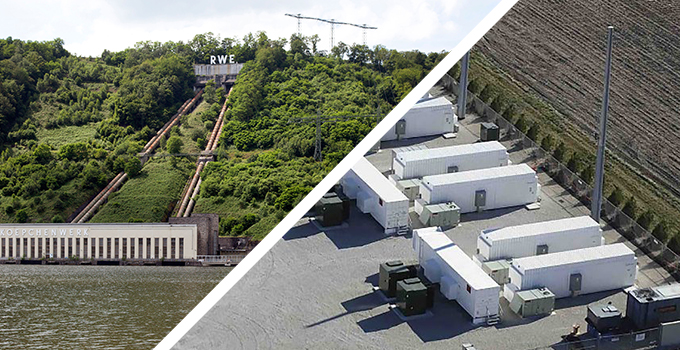
The rapid growth of renewable energy generation has been driven by two concurrent factors: the falling levelised cost of the energy produced by wind and solar, and the retirement of a number of coal-fired power stations. The recently released Finkel Review notes that by 2035, approximately 68 per cent of the current fleet of Australian coal generating plants will have reached 50 years of age.
The Clean Energy Target proposed by Dr Finkel is not yet confirmed but it recommends incentives for technologies with low or zero carbon emissions. More renewable energy generation brings new challenges in an increasingly complex grid. Dr Finkel therefore also proposes that energy storage be mandated for solar and wind farms.
Renewables can’t, on their own, meet the fluctuations in demand that occur throughout the day without some regulation as to when power reaches the grid. Power needs to be dispatchable. Dispatchable means that energy can be provided upon request. If the sun is not shining or the wind is not blowing, renewable energy cannot be dispatched unless it has been stored in some way.
There are a number of different types of storage but the two being discussed most widely right now are batteries and pumped hydro energy storage. These two technologies are very different and there are some limitations involved in comparing a well-known and established technology with one that is new and developing rapidly.
How do they support the network?
Pumped hydro is based on well-established synchronous generation, providing critical ancillary services to the grid, through the provision of inertia, frequency and voltage support and sufficient fault level support.
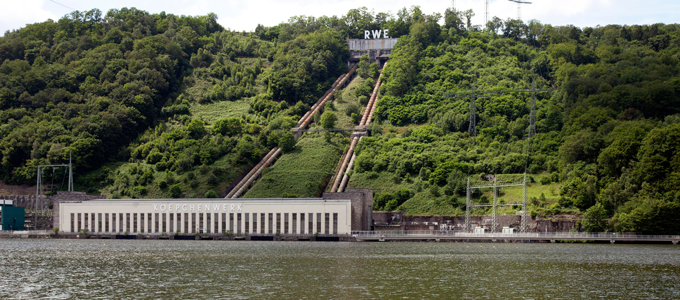
Battery inverter technologies are still catching up on most of these fronts. The potential for batteries to provide ‘synthetic inertia’ or fast frequency response is high but this is balanced by their reliance on system strength to be able to deliver this support. They offer minimal support with fault levels but can still provide some support to system frequency and voltage regulation.
How fast can they happen?
There’s no doubt that battery storage is quicker to implement than pumped hydro. South Australia has provided an example of just how quickly battery storage can be deployed.
In March 2017, the South Australian Government called for expressions of interest for the supply of grid-connected battery storage to be connected by the end of 2017. The overwhelming response from 90 interested parties tells us that this speed of deployment is within the realms of possibility.

Battery image courtesy of Greensmith, a Wärtsilä Energy Solutions company.
Pumped hydro, by comparison, is a technology that takes much longer to implement. Typically, development activities (including optimising the technical solution, environmental and social assessments, arranging finance and finalising design) take two years or more to complete, and construction takes another two to three years.
How do the capital costs compare?
Pumped hydro boasts a very low price per megawatt hour, ranging from about $200/MWh to $260/MWh. Currently, battery costs range from $350/MWh to nearly $1000/MWh, with this cost reducing rapidly (costs reduced by about 25% during 2016).
According to the Lazard’s Levelized Cost Of Storage report, capital costs for pumped storage projects around the world range from about $1.5 million to $2.5 million per MW installed. The report also reveals that the cost of installing a grid-scale battery solution ranges from about $3.5 million to $7.5 million. This wide range of pricing for batteries is typical of a developing technology that is implemented in a variety of applications.
Ultimately, it’s difficult to predict how low the cost of batteries may go, but reports predict costs of lithium-ion batteries at somewhere around $120/MWh by 2025.
Considering that batteries need to be replaced once or twice a decade, with the currently available technologies, a battery facility will need to be replaced a number of times during the potential 100-year life of a pumped storage project. For batteries, assuming an economic life of 40 years, the initial cost plus replacements may mean whole-of-life costs fall in the range of $200/MWh to $330/MWh.
So, what does the future hold?
The rise of renewables will inevitably lead to a diversity of storage and supply solutions. The range of these solutions will depend on the resources of particular regions and locations. It is highly likely that the future for both batteries and pumped storage technologies will be extremely bright.
Batteries are here to stay and will undoubtedly play a significant role in future power systems as the technology develops and costs fall. However, while batteries can provide fast response times, they are yet to demonstrate their ability to provide the full range of ancillary services needed to support the grid. Pumped hydro remains a landmark, proven and reliable technology, able to meet the needs of the grid and provide sustained output for up to a century.
Ultimately, there is room for both batteries and pumped storage hydro, and they may even complement each other. Batteries are more cost-effective at delivering small amounts of stored energy over a short time at high power levels. Pumped storage is more cost-effective at storing and releasing larger amounts of stored energy. Achieving the optimum storage solution will depend on careful planning and finding the best fit for the particular circumstances.
What is certain is that both technologies will play important roles in the development and expansion of a network powered by renewable energy.
If you would like to discuss how Entura can help you with your next utility-scale battery or pumped hydro project, please contact Donald Vaughan on +61 3 6245 4279 or Nick West on +61 408 952 315.
A version of this article was first published in RenewEconomy.
About the authors
Donald Vaughan is Entura’s Technical Director, Power. He has more than 25 years of experience providing advice on regulatory and technical requirements for generators, substations and transmission systems. Donald specialises in the performance of power systems. His experience with generating units, governors and excitation systems provides a helpful perspective on how the physical electrical network behaves and how it can support the transition to a high renewables environment.
Nick West is a civil engineer at Entura with 16 years of experience, primarily in hydraulics and hydropower. Nick’s skills range from the technical analysis of the layout of hydropower projects to the preparation of contractual project documents and computational hydraulic modelling. Nick was a key team member of the Kidston Pumped Storage Project Technical Feasibility Study.
MORE THOUGHT LEADERSHIP ARTICLES
Shifting directions for hydropower in Asia-Pacific
The issues and trends we’re seeing playing out right now relating to hydropower and the clean energy sector are not unique to our region.
Having recently returned from a meeting of the Board of the International Hydropower Association, I’ve been reflecting on the challenges and opportunities facing the global hydropower sector.
It seems that there’s a global shift occurring in hydropower. Traditionally, hydropower has been viewed as a stand-alone, established renewable technology. Now we’re seeing a much greater sense of integration with other renewable technologies as part of broader ‘clean energy’ systems. With the rapid global increase of wind and solar power developments, hydropower needs to review its place, and its opportunities, within the wider energy sector.
Wind and solar tend to have shorter construction and implementation periods than hydropower projects. When the wind is blowing and the sun is shining, the power flows. But, as we know, the intermittency of these sources of power creates the need for some sort of storage to firm up the system.
Hydropower has traditionally provided both baseload and peaking capacity, but now we also have the opportunity to provide much-needed storage and the firming capacity urgently required to help stabilise grids as they integrate increasing levels of intermittent renewable technologies. Pumped storage hydropower may be particularly useful in this context.
In recent weeks the Australian federal government has expressed new interest in pumped storage options to help alleviate grid pressures, such as those experienced recently in South Australia. But it’s not only in Australia that we’re seeing increased discussion and enthusiasm about opportunities for pumped storage hydropower to integrate with other intermittent renewable technologies by offer firming power and assistance with stabilising the grid. It’s a global trend.
Also under discussion at a policy level in Australia right now is the energy ‘trilemma’ of security, equity (accessibility and affordability) and environmental sustainability. These three factors need to be in balance to ensure a secure power sector that meets the present and future needs of energy consumers while moving towards a lower carbon future. These three big issues that are so relevant right now in the Australian context are just as urgent in the global setting too, and need careful long-term planning, and the right mechanisms in place to support appropriate development.
It is interesting to review the World Energy Council Energy Trilemma Index, noting country rankings through the lens of hydropower and pumped storage integration. Not surprisingly, most countries ranked at the top of the list have been using these technologies for decades, which perhaps signals a direction for others to consider.
Another worldwide trend is the ongoing shift towards development of small to medium hydropower systems because many of the larger opportunities have already been exploited. For example, in China, many of the large hydropower schemes (10 000 MW, plus) have already been identified or developed, so new hydro developments are more likely to fall within the small to medium range, with the added advantage of shorter construction and implementation times. In Australia, smaller pumped hydro systems, or hydropower systems built into irrigation systems or water supplies, also have a significant role to play in the ongoing development of the hydropower sector.
Renewable energy and hydropower is a specialised field, so it’s critical that we also focus on the human resources and the capacity development needed to ensure a healthy future for the global hydropower sector. This is particularly so in regions which are new to hydropower and renewables, as the world shifts towards stronger support for renewables and replacing carbon-intensive power generation.
Hydropower is a mature, established technology, but that doesn’t mean we can’t be flexible and responsive to shifts in the global energy sector. As we strive towards the goal of affordable, reliable and sustainable power for all, hydropower has much yet to offer as a stabilising element of an integrated clean energy vision.
About the author
Tammy Chu is Entura’s Managing Director. She is responsible for Entura’s business strategy, performance and services to clients, and is part of Hydro Tasmania’s Leadership Group. Tammy joined the business in 2000 and has held a range of positions at Entura, from Technical Professional to Project Manager, Business Development Manager and Water and Environment Group Manager.
She has extensive managerial and business development experience in the consulting engineering industry within Australia and internationally, focusing on business strategy, change and transformation, international sales, culture, and profit and revenue growth.
As a civil engineer, Tammy specialised in the design and construction of mini-hydro and hydropower systems, project management, hydropower investigations, prefeasibility and feasibility studies, environmental assessments and approvals, resource investigations and resource water management.
Tammy is a member of the Board of the International Hydropower Association. She was the first female and now past president of the Tasmanian Division of Engineers Australia, and was an Engineers Australia National Congress representative.
Tammy holds a Master of Business and Administration from Chifley Business School, is a Fellow of Engineers Australia, and a graduate of the Australian Institute of Company Directors.
MORE THOUGHT LEADERSHIP ARTICLES
Overcoming the barriers to pumped storage hydropower
With energy reliability a hot topic in Australia, eyes are now turning to pumped storage hydropower… but what has been holding it back?

There are only three pumped storage hydropower projects in Australia, with the most recent completed more than thirty years ago. This is despite the ability of pumped storage hydropower projects to provide the large-scale storage that would complement increasing levels of renewable energy. Why is this, and what are the barriers to developing more Australian pumped storage hydropower projects?
Around the world, pumped storage hydropower projects make up the vast majority of grid energy storage and have traditionally been used by energy utilities to supply additional power to a grid during times of highest demand.
As part of a portfolio of power stations, a utility might operate a pumped storage project infrequently only, if the cost of pumping the water back to the upper storage exceeds the revenue that can be generated from its release.
The main issue facing developers trying to prove the viability of a new pumped storage project is that a sufficient price differential is required to pay for the pumping and to account for the efficiency losses in transmission, pumping and generation. The generation price needs to be sufficiently higher than the pumping price just to repay the variable pumping costs. To repay the heavy capital investment, a margin is required over and above the break-even cost of pumping. This is particularly true where proposed developments are ‘stand-alone’ and cannot be optimised as part of a corporate generation portfolio.
In recent years, electricity price spikes have been irregular with few occurrences each year. Due to the significant capital costs, a pumped storage scheme would require a certain number of pumping/generation cycles at high or maximum pricing to pay a return on investment. These price spikes are unpredictable, so building a business case around these events is risky.
Historically, the daily fluctuation of power prices has not been sufficient or regular enough to attract pumped storage developers. This is beginning to change with increasing penetration of renewable energy leading to an increase in both low and high price periods. More frequent, sustained periods of hot weather (as predicted by climate change models) will also drive up demand for power and therefore the market price.
In the last few months, volatility has greatly increased, creating a greater differential between baseload and peak pricing. This will increase the viability of pumped storage schemes, although the unpredictability and challenges of financing capital intensive assets will remain.
But, even when the economics are right, there are still some other barriers that proponents of pumped storage projects need to overcome:
Finding the right site
Pumped storage projects require significant capital for development. Minimising the cost of construction and operation is key to the successful development of a project. Choosing the right location is a matter of identifying a site with ideal topography, a source of water and good proximity to and location within the transmission network.
A wealth of information is available that is relevant to identifying potential pumped storage hydropower sites. Concept studies for pumped storage hydropower sites can screen potential sites quickly and offer developers greater insight into possible opportunities.
Negotiating access to appropriate sites for pumped storage
While a pumped storage project generally has a significantly smaller footprint than a traditional hydropower project, the features of natural topography that are ideal for pumped storage – high, steep hillsides or cliffs – tend also to be places of great natural beauty and are often designated as reserves, are expensive private land, or have high environmental or social value.
State governments can assist here through streamlined planning and approvals processes for infrastructure developments. This can make sure that the challenges of developing sites do not become insurmountable for developers.
Perceived environmental impacts
Pumped storage projects can occupy many square kilometres and also require transmission lines to connect to the electricity market. Like traditional hydropower projects, pumped storage projects need to attend to environmental issues associated with the project. Environmental impacts for pumped storage projects are assessed in the same manner as for all infrastructure developments.
If the impacts of a project can be mitigated to the satisfaction of the relevant regulatory body and international Standards (such as the International Hydropower Association and International Finance Corporation), a pumped storage hydropower project should face no greater hurdle than any other infrastructure project in this respect.
A pumped storage project may also have to deal with the perception that it uses carbon-intensive thermal power to pump water during the pumping cycle. This may be true unless there is a surplus of renewable energy available, in which case the pumped storage project could be seen to be using this excess renewable energy for pumping. As renewable energy penetration grows, the opportunities for storing surplus renewable energy will increase.
An unfavourable regulatory framework
Inconsistent and uncertain policy positions of the major political parties at both federal and state levels reduce confidence in the energy industry, which deters investment. With debate raging over energy security, a bipartisan view on energy policy, which transcends party politics and the electoral cycle, is urgently needed.
Existing mechanisms are in place to support the renewable energy industry. The Renewable Energy Target (RET) promotes investment in renewable energy projects; however, pumped storage is specifically excluded from the RET where the energy used for pumping exceeds the energy generated. Current policy would have to be amended or complementary legislation enacted in order to reward large-scale storage for the service it provides.
Such changes could include market mechanisms for large-scale storage that could offer incentives for providing inertia and ancillary services from storage at times of peak demand as well as power. Another possible change could be to ensure that large-scale storage asset owners are not penalised under the RET for energy used in the pumping process. This would encourage the development of energy storage as a complement to the growth of renewable energy.
High cost of development activities
The long lead times and high development costs of pumped storage projects are major deterrents to developers. Projects generally take more than 4 to 5 years from the point of conception to ‘power on’, and require millions of dollars of capital for development and hundreds of millions for construction. In other words, when funding is first committed, it may not see a return for five years or more.
In an effort to overcome this barrier, the Australian Renewable Energy Agency (ARENA) has indicated it will allocate at least $20 million to finance the accelerated development of flexible capacity and large-scale storage projects. The Clean Energy Finance Corporation (CEFC) has also committed to provide successful ARENA funding recipients with the opportunity to secure long-term debt finance to support their projects.
With an increasing interest and emphasis on storage in a power system that is becoming increasingly unreliable (e.g. load shedding in South Australia and lack of reserve events in New South Wales), and with finance from ARENA and CEFC for large-scale storage, the barriers to pumped storage development are gradually diminishing. This action can’t come soon enough for residents suffering through blackouts on days over 40°C.
If you would like to discuss how Entura can help you overcome the barriers for a pumped storage hydropower project, please contact Patrick Pease, Nick West on +61 408 952 315, or Richard Herweynen on +61 3 6245 4130.
A version of this article has been previously published as an op-ed in the Adelaide Advertiser.
About the authors
Nick West is a civil engineer at Entura with 16 years of experience, primarily in hydraulics and hydropower. Nick’s skills range from the technical analysis of the layout of hydropower projects to the preparation of contractual project documents and computational hydraulic modelling. Nick was a key team member of the Kidston Pumped Storage Project Technical Feasibility Study and was involved throughout the development and construction of the Neusberg Hydroelectric Project in South Africa. Nick has successfully completed projects ranging from hydraulic design for small residential developments to the feasibility study of a cascade of four large hydroelectric projects in Malaysia.
Richard Herweynen is Entura’s Technical Director, Water. Richard has three decades of experience in dam and hydropower engineering, and has worked throughout the Indo-Pacific region on both dam and hydropower projects, covering all aspects including investigations, feasibility studies, detailed design, construction liaison, operation and maintenance and risk assessment for both new and existing projects. Richard has been part of a number of recent expert review panels for major water projects. He participated in the ANCOLD working group for concrete gravity dams and is the Chairman of the ICOLD technical committee on engineering activities in the planning process for water resources projects. Richard has won many engineering excellence and innovation awards (including Engineers Australia’s Professional Engineer of the Year 2012 – Tasmanian Division), and has published more than 30 technical papers on dam engineering.
MORE THOUGHT LEADERSHIP ARTICLES
Is pumped storage hydro the key to increasing renewables in Australia?
Recent electricity price spikes and a state-wide blackout in South Australia have highlighted the need for reliable power to balance the potential volatility of some renewable power sources.
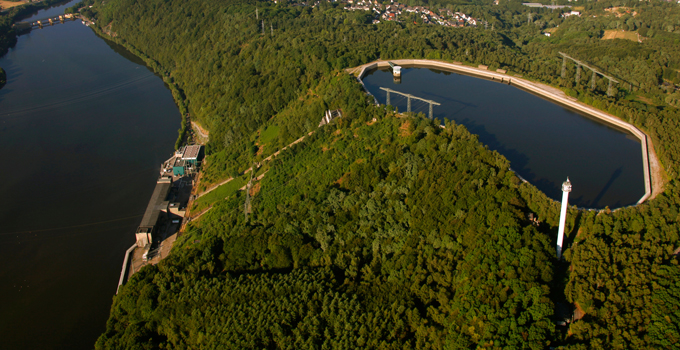
Pumped storage hydropower projects are a natural fit in an energy market with high penetration of renewable energy as they help to maximise the use of the renewables that are subject to the vagaries of the weather. Pumped storage provides a load when the wind is blowing and the sun is shining, and it also provides a reliable and immediate source of energy when the sun has set and the wind has dropped.
The recent completion of the feasibility study for Genex Power’s Kidston Pumped Storage Hydro Project in North Queensland shows this approach is now technically and commercially feasible.
Pumped storage hydro offers utility-scale storage and system stability
As the proportion of renewable energy in an energy market increases, the need grows for the stability and consistency provided by utility-scale energy storage. For example, South Australia needs system-wide storage of 500 MW for a period of 10 hours to improve the flexibility of wind farm operators, according to the Melbourne Energy Institute.
At the smaller scale of energy storage, the buzz about various types of batteries continues – but the only storage option with a proven track record at the utility scale is pumped storage hydropower.
Pumped storage hydropower works by pumping the water stored in a lower reservoir into a more elevated reservoir. The water stored at height can be passed through a turbine on its path back to the lower reservoir, creating electricity as and when needed, and making the best use of the water resource without waste.
In a recent article, my colleague Donald Vaughan stated that a functioning AC power system needs inertia, fault level, frequency and voltage control as well as energy sources to function to an acceptable standard. Pumped-storage assets can provide all of these important contributions to a stable and successful power system, levelling out the fluctuations in availability of wind and solar energy, and helping to regulate voltage and frequency.
New opportunities for pumped storage hydro in Australia
Despite the significant potential and benefits of pumped storage hydro projects, only three projects currently exist in Australia (two in New South Wales and one in Queensland). These schemes were built in markets in which generation was mainly thermal, where the pumped storage could supplement supply at times of peak demand.
A number of possible sites have been identified for new opportunities for pumped storage hydro, but so far very few have been developed beyond concept level. This means that opportunities exist for developers in states such as South Australia and Queensland that have set ambitious renewables targets and must maintain energy security.
Three factors for pumped storage hydro success
For successful pumped storage hydro projects, developers need to identify a viable site, achieve a technically and commercially feasible design, and make the most of the economics of the energy market.
1 – Identifying a viable site
For a pumped storage project, what’s needed is a source of water, and two reservoirs separated by a significant change in elevation. The water could come from a nearby river, an existing reservoir, or the sea. With many thousands of potential sites across the country, a developer needs smart methods of filtering to reduce the many possibilities to just a few ideal sites.
An important consideration is the effect on the viability of pumped storage projects of the relative remoteness of sites, through both the efficiency of the power’s round trip and the marginal loss factors (factors applied to a generator or a load, and calculated based on the size and distance of the generator or load from a central point).
As for any development, the process of identifying sites must also consider topography, land use and environmental constraints. Pumped storage projects generally present similar but reduced environmental risks as conventional hydropower projects as they tend to have smaller footprints.
2 – Achieving a technically and commercially feasible design
Entura’s experience on Genex Power’s Kidston pumped storage hydro project has shown that it is possible to construct low-cost pumped storage projects in Australia through careful site identification and clever project design. Where a pair of suitable reservoirs don’t already exist, constructing a turkey’s nest dam may offer a solution.
A turkey’s nest dam is a reservoir built by excavating earth from the centre of the reservoir and moving it to the edge to help form a continuous embankment. Turkey’s nest dams have been used successfully around the world in pumped storage hydropower projects, providing opportunities to build projects where elevation changes significantly over a short distance.
Additionally, turkey’s nest dams can help to minimise capital costs by reducing conduit lengths and maximising head (the difference in elevation between the upper and lower reservoirs).
3 – Making the most of the economics of the energy market
Understanding the opportunities and constraints in the energy market is critical to a pumped storage project’s financial viability.
When you can store energy, you can dispatch electricity at peak times, gaining the highest price point in the market. Conversely, water is pumped to the upper reservoir in off-peak periods or when supply from renewable sources is high and market prices are low. This ‘energy arbitrage’ makes the most of the price difference in the electricity market.
Selecting the optimum installed capacity of a pumped storage project also requires detailed understanding of energy markets. It is possible that a pumped storage project can act to flatten peak prices to the point where the returns on a project are insufficient to meet financiers’ hurdles, so detailed revenue modelling is essential to determine the tipping point between enough and too much installed capacity.
With careful selection of sites, clever design, and the right mix of capacity and costs, pumped storage hydro holds an important key to unlocking the full potential of renewables in Australia’s electricity market.
If you would like to discuss how Entura can help you explore potential opportunities for pumped storage hydropower projects, please contact Nick West on +61 408 952 315 or Richard Herweynen on +61 3 6245 4130.
About the author
Nick West is a civil engineer at Entura with 15 years’ experience, primarily in hydraulics and hydropower. Nick’s skills range from the technical analysis of the layout of hydropower projects to the preparation of contractual project documents and computational hydraulic modelling. Nick was a key team member of the Kidston Pumped Storage Project Technical Feasibility Study and was involved throughout the recently completed Neusberg Hydroelectric Project in South Africa. Nick has successfully completed projects ranging from hydraulic design for small residential developments to the feasibility study of a cascade of four large hydroelectric projects in Malaysia.
MORE THOUGHT LEADERSHIP ARTICLES
Five steps to better understanding geological risks in hydropower projects
Not fully understanding the geological conditions is one of the biggest risks in a hydropower project, and can lead to large cost blow-outs, major repairs and even public safety issues.

Understanding the geological conditions enables engineers to design safe and stable structures, and to minimise project and financial risk. The geological risks don’t stop at the dam site, but also extend to the spillway, powerhouse, tunnels and other structures.
Hydropower developers often ask: ‘how much should I spend on geological investigations for my hydropower project?’ and ‘how many drill holes do you normally need for a dam site?’
The answer depends on what is already known and what risks have been identified through the available regional geology and the geological mapping of the site. Geological investigations aim to understand the risks at the site by progressively developing a geological model.
Five steps to achieving a good geological model
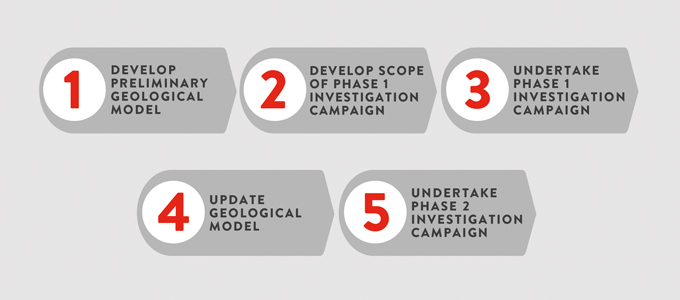
It is important to have a clear, systematic process to achieve a good geological model and, therefore, ensure that the subsurface geological risks are well defined.
Entura has developed and adopted the following five-step process:
Step 1 – Develop preliminary geological model
The first step is to develop a preliminary geological model of the site based on available geological information, aerial photos, topographic data and geological surface mapping. Spending the necessary time to source and collate all the available information is valuable.
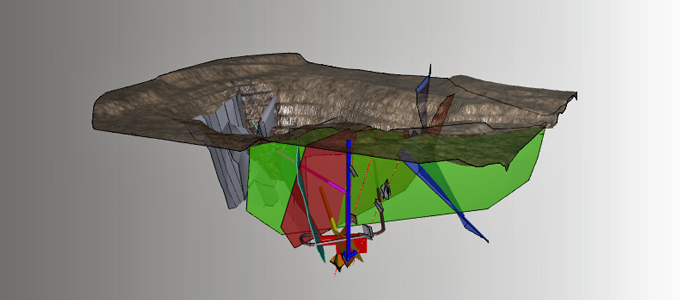
The model should include not only the geological units but also the main defects such as bedding, joints, shears and faults. Understanding the main defects helps to determine whether there are any potential failure mechanisms within the foundations underlying the project structures.
Step 2 – Develop scope of phase 1 investigation campaign
Based on this preliminary geological model, we can determine what needs to be confirmed or known, and then plan the phase 1 investigation campaign. The investigations must relate strongly to what you are trying to confirm or determine with the geological model. Without this strong relationship, the developer may be wasting money.
The investigation techniques planned depend on many factors including known geological conditions, information gaps, environmental constraints, site access, available skills and equipment, time and cost. There should be a clear objective for every test pit excavated, geological hole drilled, geophysical survey performed and laboratory test undertaken.
The outcome of Step 2 is the scope of works for the phase 1 investigation campaign. The development of the scope of works is a task in itself and should be performed by a suitably qualified engineering geologist. The preparation of a scope of works ensures that the developer can call for quotations from prospective consultants and contractors with confidence that the campaign will be targeted at improving the understanding of the identified geological risks.
Step 3 – Undertake phase 1 investigation campaign
The third step in developing a good geological model is to undertake the phase 1 investigation campaign.
The investigation campaign should be supervised by an appropriately qualified engineering geologist who is empowered to direct the investigations contractor and who has the flexibility to adjust the investigations as necessary based on the site observations.
For example, the core is not the only result of a drilling excavation: drilling rates, water loss, the colour of drill cuttings, hole collapse and groundwater levels all provide important information that is not visible in a core tray.
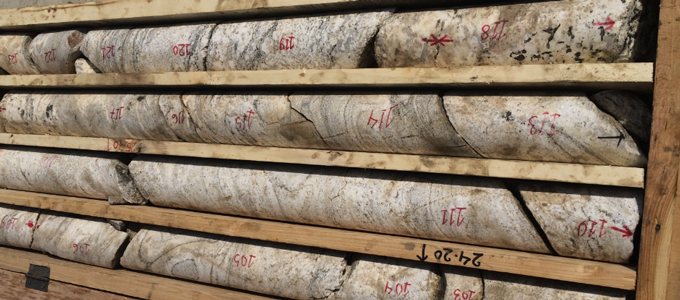
Local contractors are commonly engaged for geological investigations due to the need for heavy excavators and drill rigs. The contractors must be experienced with well-maintained equipment that is appropriate for the task (hole size, hole depths and geological conditions). Appropriate drilling techniques are required to maximise core recovery in the areas of interest, even if they take some time.
Developers must not underestimate the challenges of site access. A significant amount of time can be lost repairing broken plant in remote locations, so the proposed plant should be inspected and tested before site mobilisation.
Laboratory testing should only be performed at reputable laboratories, otherwise there is a risk of destroying samples and wasting time and money for little benefit. Typically, we use local laboratories for common tests, such as those used for concrete manufacture or road construction, and we may use specialised laboratories for more complex or unusual testing.
The outcome of Step 3 in our five-step process is significantly more factual geological and geotechnical information.
Step 4 – Update geological model
Step 4 is to interpret this additional factual information, and to update the preliminary geological model (developed in Step 1). This will improve understanding of the geological risks at the site, which is the key return on the investment made in the investigation program.
Step 5 – Undertake phase 2 investigation campaign
Step 5, the final step in the process, is a phase 2 investigation campaign. It is very common for hydropower projects to undertake more than one geological investigation campaign. This is because the geological model may change due to the information discovered in the first campaign, which may raise further questions or unknowns.
The second campaign, if required, is likely to be very focused, as it will be addressing a specific question, and will help to finalise the geological model.
Asking the right questions
Rather than asking how many holes are normally drilled for a dam project or how much money is normally spent on geological investigations, hydropower developers should ask: ‘is the money being spent wisely and for a clear purpose?’
Geological investigations do not reduce geological risks; they merely improve the understanding of the risks. A good understanding of the geological conditions reduces the uncertainty of capital cost, and therefore enables developers to make well-informed and less risky investment decisions.
To discuss how Entura can assist you to better understand the geological risks to your hydropower project, please contact Shekhar Prince on +61 412 402 110 or Richard Herweynen on +61 3 6245 4130.
About the author
Richard Herweynen is Entura’s Technical Director, Water. Richard has three decades of experience in dam and hydropower engineering, and has worked throughout the Indo-Pacific region on both dam and hydropower projects, covering all aspects including investigations, feasibility studies, detailed design, construction liaison, operation and maintenance and risk assessment for both new and existing projects. Richard has been part of a number of recent expert review panels for major water projects. He participated in the ANCOLD working group for concrete gravity dams and is the Chairman of the ICOLD technical committee on engineering activities in the planning process for water resources projects. Richard has won many engineering excellence and innovation awards (including Engineers Australia’s Professional Engineer of the Year 2012 – Tasmanian Division), and has published more than 30 technical papers on dam engineering.
MORE THOUGHT LEADERSHIP ARTICLES
Hydropower generates opportunities for businesses in India
In recent years, India has emerged as a world leader in renewable energy and this growth is presenting opportunities for businesses looking to diversify their activities.
A range of renewable energy developments such as wind and solar, from the smallest to the largest scale, are planned and getting underway all around India. There’s also still plenty of untapped potential for hydropower, particularly in the rugged north and north-west of the country.
Estimates suggest that less than a third of the country’s potential for hydropower has so far been exploited – and that presents an opportunity for organisations seeking to embrace renewable developments as part of their commitment to sustainable social and industrial development, quality of life, and a clean energy future for the nation.
The time is ripe for private investment in hydropower in India. Significant government incentives and subsidies are available to encourage increased hydropower development. Hydropower also offers added value to the power network in the form of immediately dispatchable power to balance any variability of solar and wind output.
Enthusiasm and opportunities are two important factors leading to hydropower success, but another critical factor is reliable expertise, and this may be less available to many potential proponents of hydropower projects if they are new to the hydropower sector.
Progressing through all the necessary steps of any power development process is difficult at the best of times, let alone for a developer who has little or no prior experience.
Hydropower, like all power developments, has its challenges: land acquisition, resettlement, rehabilitation, geology, technical challenges in dam and scheme design and construction, financing, and so on. These challenges can be considerable, but can also be overcome with the right expertise on hand.
Chanju-I hydropower project: a success story
When Indo Arya, a large conglomerate with interests in steel, thermal power and logistics, decided to make its first foray into hydropower, it recognised the need to engage an experienced hydropower consultant and it turned to Entura to provide the long-term support to ensure the hydropower project’s success, from the earliest feasibility study right through to operation.
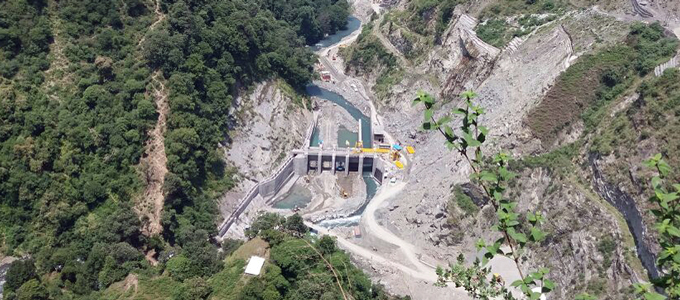
I A Energy, a special purpose vehicle, was formed for implementation of the Chanju-I run-of-river hydropower project in the Indian province of Himachal Pradesh. I A Energy provided all the financial and management capabilities, while Entura provided the technical expertise and project development knowledge.
Entura’s ongoing role in this project, supporting the client across all project stages as a trusted advisor, went beyond what might be described as ‘owner’s engineer’, achieving a considerable level of collaboration between developer and consultant that enabled the project’s success.
Now, nine years since the earliest site visits, the Chanju-I run-of-river hydropower project is set to deliver its 36 MW of renewable electricity, thanks to the power of the water flowing downstream from the confluence of the Bhararu and Chanju rivers. The project will generate attractive financial returns for its owner and the State Government, but will also directly benefit the local community, with power, tuition and health services.
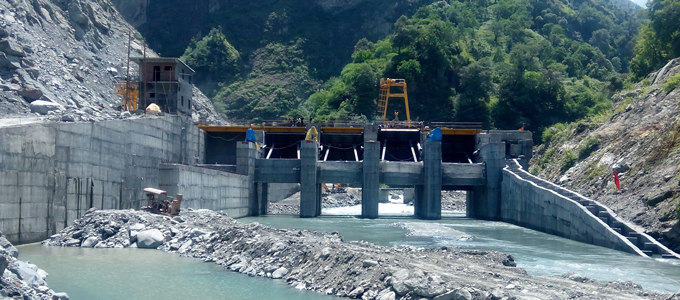
Entura’s involvement over the full cycle of the project helped I A Energy ensure the right location, access and water availability for a viable project. We recommended the site, and then worked closely with the client to progress the project through its various stages, including site investigations, exploration of hydropower potential, environmental impact assessment, feasibility assessment, project approval, tender design, detailed design and construction advice and support.
Entura also assisted I A Energy to set up the organisation of the project and quality procedures on site, and our engineers regularly attended the site to provide ongoing advice and support during construction.
The project involved constructing a 16m-high barrage, a 5km-long headrace tunnel, two underground desilting chambers, pressure shafts, and a surface powerhouse. Entura provided technical expertise in optimising the design and construction, costing, contract packaging, selection of equipment, scheduling and project management. Our involvement delivered valuable outcomes such as increasing the asset capacity from 25 MW to 36 MW.
Overcoming project challenges
During the development phase, the Chanju-I project faced many issues and challenges with the potential to stop or significantly delay the project. These issues included approval delays, environmental issues, stakeholder management, and disagreements with upstream developers with respect to the location and height of the barrage, river basin development plans and infrastructural development.
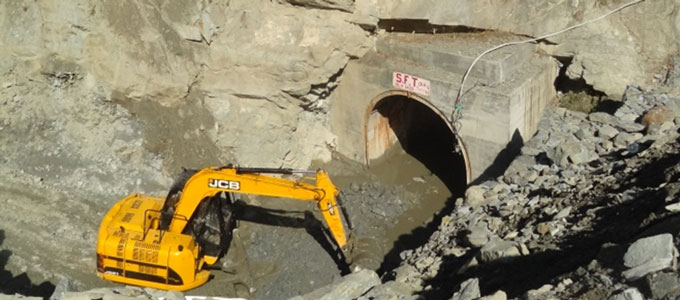
Entura’s continuous involvement, timely advice and support during critical situations helped the project team stay on top of these challenges, ensuring ultimate project success. In spite of the hurdles, the collaborative approach provided an efficient mechanism to address the issues and move the project forward at all times, even enabling early commencement of construction. By fast-tracking the construction of the project, the developer maximised its returns, and the project has been noted for its speed and efficiency in construction.
The way Entura serviced the project was praised by the project authority and strengthened our relationship with I A Energy. The longevity of Entura’s engagement with I A Energy on the Chanju-I project demonstrates the importance we place on delivering well for our clients, whether the project is small or large, and our ability to work as a valued and reliable partner of the client throughout the full project lifecycle.
To find out more about making the most of the opportunities available in the global renewable energy sector, please contact Shekhar Prince on +61 412 402 110.
MORE THOUGHT LEADERSHIP ARTICLES
Getting hydropower right: The six key considerations for a successful project
So, you want to develop a hydropower project? Any hydropower development is a major undertaking, so you need to be sure you get it right.
In our increasingly electricity-dependent world, hydropower offers a cost-effective and environmentally sustainable, clean-energy solution with significant development opportunities in Asia and Africa particularly.
Solving the technical challenges to establish a reliable hydropower scheme may seem complex, but engineering issues are only one part of the equation and may even be relatively straightforward compared with some of the broader issues and risks affecting a project’s success or failure.
Hydropower developments are more likely to gain social and regulatory approval, adequate and secure finance, and be successful in the short and longer term, if you pay early and detailed attention to the following six key considerations.
1 – What is the resource and how might it change?
Properly investigating the long-term history and variability of an area’s water resource is essential to the success of any hydropower project. However, even in areas in which water availability may have been reasonably consistent in the past, climate change introduces a new level of uncertainty for future projections.
To maximise the success of a new hydropower development for the short term as well as long into the future, it is essential to build climate resilience into projects. This requires specialist hydrological modelling based on the best historical data combined with expert future projections, taking into account the range of potential impacts on climate, rainfall, inflows and water availability.
Climate effects may not always mean reduced water availability. In some cases, the hydropower scheme may need to be able to accommodate and optimise the use of increased rainfall or inflow.
However uncertain the future resource, thorough investigation of what is currently known and what can reasonably be projected gives you the best chance of a successful, climate-proof scheme that can withstand future inflow variability and other longer term changes in the catchment.
2 – How stable is the proposed location?
One of the greatest potential complications and causes of delay in a hydropower development project is an unwelcome geological surprise.
Thorough, specialised investigation of the proposed site’s topology, geology and seismic risk is crucial, and can greatly impact cost, financing and viability. The more stringent and detailed the preliminary geological and geotechnical investigations, the more likely you are to avoid problems through the construction period and deterioration of the infrastructure over time.
This is particularly important where a large dam is proposed, as the extra weight of the water, concrete and sedimentation creates massive forces on the dam’s foundation, which may cover a large area and a potentially geologically diverse set of subsurface conditions. The choice of the appropriate dam type and construction method must be influenced by the unique conditions of the dam site, and stability of the site is a key consideration.
3 – How much power do you need now and will that change?
Populations and their demands for power don’t stay static for long. It’s important to think about the broader demographic of the region in which your scheme is to be developed. Is the population growing rapidly due to an ongoing rising birthrate, or could it shift significantly due to changes in neighbouring regions creating population movement?
Furthermore, industrial demand needs to be carefully projected, especially in a growing economy. What is the future development potential of local towns or cities? Is there potential for any major new industry in the region that may rapidly increase the power demand? On the other hand, are there any foreseeable threats to existing major industries that may suddenly lower demand?
As technology and lifestyle expectations change, especially in developing nations, residential demand may also rise rapidly. This demand can also be significantly, although usually predictably, variable, such as where climate extremes create peak demand coinciding with heating or air-conditioning requirements.
Another important factor, particularly in Asia and parts of Africa, is the potential for power generated in one country to be sold to neighbouring countries.
4 – Can you get the power to where it is needed?
A power source is only useful when it can reach a potential user. So another key consideration for a successful hydropower development is the ability to deliver the power to where it is needed through existing, upgraded or new transmission and distribution infrastructure.
Commonly, the best economic outcome of a power development is when much of the load can be used near to where it is generated, as this lowers the costs of transmission development, and lessens the loss of power when it is transferred over distance. Those few percentage points of power loss over distance could make the difference in the overall financial return on investment.
Careful planning of the routes for transmission and distribution lines is critical to success, with sizeable implications for project costs if lines must cross remote or rugged terrain, or socially or environmentally sensitive areas.
5 – What social and environmental impacts are possible?
From the earliest thoughts and discussions about a new hydropower development, it is critical to consider the project’s stakeholders, community and environment. As well as providing benefits to a project’s owner, electrification can deliver significant benefits to affected communities, raising living standards, alleviating poverty, helping to develop and diversify economic activities, as well as potentially improving water availability and management. However, hydropower should never be developed to the detriment of affected communities or the environment.
A ‘social licence to operate’ is fundamental to long-term success of your hydropower project. This can only be achieved where due consideration is given to social and environmental impacts throughout the project lifecycle, including those around changes in land use and ownership, and adequate consultation and engagement is undertaken with affected communities so that they receive a net benefit from the project.
Stakeholder engagement is the key to determining appropriate avoidance, mitigation, offsetting or compensation of any potential impacts – both immediate impacts, and impacts that may only emerge in the longer term. The most successful consultation is the ‘bottom-up’ and transparent approach, where affected communities are engaged and involved in the project right from its inception.
Safety is also a critical issue to be managed throughout a project’s life, including the safety of construction workers, ongoing employees, and the broader community. Identifying key safety risks early and managing them appropriately throughout design, construction and ongoing operation is critical to protecting a developer or owner against the major social and environmental consequences of a safety incident, as well as the long-term damage to that business’s reputation and financial viability.
6 – Can you obtain finance?
No hydropower project will succeed without available, secure project financing. Although hydropower developments offer opportunity to developers and financiers, lenders around the world are increasingly cautious and will require evidence of best-practice and sustainability to release project funds. They will need a range of risks to have been adequately investigated and mitigated, including all those considered above, as well as local political and regulatory issues.
A useful tool to evaluate the sustainability and strengths of a hydropower project and identify any further opportunities for risk mitigation is the Hydropower Sustainability Assessment Protocol.
Using a framework such as this offers investors greater confidence that their investment is safe, and that structured and systematic efforts have been undertaken to foresee risks across the spectrum of financial, technical, stakeholder, community and environmental issues.
Although not all risks can be avoided, this is the closest we can reasonably get to being confident that the project will not encounter any significant delays or problems through its lifecycle and will deliver the social, environmental and economic benefits it promises.
To discuss how Entura can help you plan and deliver a successful hydropower project, please contact Shekhar Prince on +61 412 402 110.
MORE THOUGHT LEADERSHIP ARTICLES
Managing risks for successful, sustainable projects
All power and water projects involve risks. The key to project success and sustainability is being able to anticipate, monitor and manage the full range of risks throughout the project lifecycle.
For power and water asset developers, sustainability is increasingly recognised as a key marker of project success and corporate reputation. Whether you’re building a hydropower station, a dam, a wind farm or a solar farm, achieving sustainability means ensuring that projects appropriately balance technical, environmental, social and economic considerations to deliver benefits and minimise risks across all these areas.
Power projects, especially in developing countries, hold great potential to contribute to the greater good by increasing prosperity and alleviating poverty, but growth must be balanced against any current and future impacts on communities or the environment. Sustainability is therefore a key concern for responsible developers, and for international financing organisations such as the Asian Development Bank, the International Finance Corporation and the World Bank.
Managing risks carefully, ethically and transparently can improve the financial and technical viability of the project, the ability to secure finance, the ability of key stakeholders to make informed decisions about the project’s future, the likelihood of community acceptance or ‘social licence to operate’, and the overall project outcomes, both now and for long-term success and sustainability.
What are the risks?
Some of the key risks to be considered throughout the design, development and operation of a power or water asset include factors such as the need or market for the project, the future energy or water demand, the best technology or design for the project, and the current and future availability of the resource.
It is also critical to consider the project’s stakeholders and broader community, particularly whether the project could involve potential social or environmental impacts and how these could be avoided, mitigated, offset or compensated, not just during development of the project but also during operation. Safety is also a key issue to be managed throughout a project’s life, including that of employees as well as the broader community.
Although not all risks will necessarily be able to be fully predicted, businesses are likely to gain substantial benefits from making structured and systematic efforts to foresee risks across the spectrum of financial, technical, stakeholder, community and environmental issues.
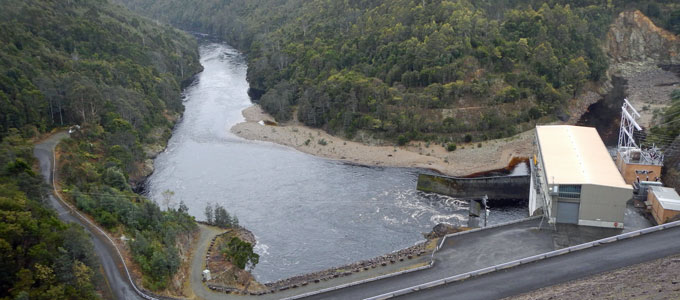
Assess risks early and often
Many project risks can be minimised or mitigated if they are properly anticipated early in the project, and progressively monitored and evaluated throughout the design, development, construction and operational phases.
Identifying key risks early allows companies to manage these risks throughout the project, minimising corporate, technical, environmental and social impacts and their associated costs, including damage to corporate reputation should an unmanaged risk develop into a crisis.
Assessing the risks progressively or in stages can minimise not only the cost of formal evaluation, but also save significant time and costs that could be wasted if a project were to be judged unviable during development.
Sustainability assessment, both formal and informal
Being able to formally or informally assess and comprehensively document risks and actions towards project sustainability offers significant advantages. While it can help guide a comprehensive review of risks, it can also help to identify further opportunities to increase positive outcomes. As well, it provides an easy way to regularly assess progress towards sustainability goals against established baselines, and offers a format for clear reporting both internally and to external funding bodies and stakeholders. In other words, sustainability assessment and reporting is a valuable step in demonstrating a genuine commitment and responsible approach to achieving greater sustainability.
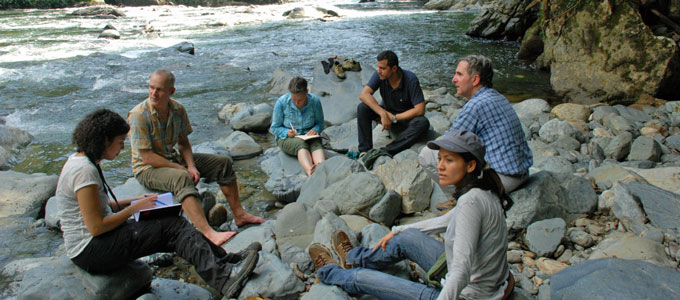
Entura uses a unique, tailored self-assessment tool to help power and water companies and developers understand the risks and opportunities facing their projects and build their capacity to assess, monitor and report on those projects. This tool is based on the assessment criteria identified in internationally recognised guidelines and standards such as the Hydropower Sustainability Assessment Protocol and those used by the International Finance Corporation.
The sustainability scanning tool can be used by an organisation to self-assess a project to identify whether key issues, risks and opportunities have been fully considered and to identify potential gaps needing further attention. This can be done internally following training on how to assess the criteria or undertaken by Entura’s trained assessors.
In addition, Entura’s sustainability scanning tool can be adapted to include other standards relevant to a project or client, or to assess compliance with criteria relevant to a client’s requirements or obligations (such as internal policies and/or permit or concession conditions). It can be used at any stage, or multiple stages, of a project, and for any level of sustainability goal (i.e. good practice or best practice). It can also be repeated over time for the same project to assess ongoing improvement, or to compare projects across a client’s portfolio.
The potential benefits to power and water asset developers of a systematic and thorough identification and management of the full range of project risks include easier access to finance, reduced corporate risks and costs, greater ability to anticipate and respond to stakeholder concerns, and avoidance of delays and problems through the project’s life.
This holds promise for delivering power and water infrastructure projects that are more likely to contribute positively to social, environmental and economic goals both now and into the future.
If you would like to discuss how Entura can assist you with assessing the sustainability of your project or support you to assess and track your own progress towards minimising risks and increasing sustainability, please contact Dr Eleni Taylor-Wood on +61 3 6245 4582 or Shekhar Prince on +61 412 402 110.
About the author
Dr Eleni Taylor-Wood is Entura’s Principal Consultant, Environmental and Social Science. Eleni has 20 years’ experience successfully managing large-scale, complex projects, as well as providing expert advice and independent review for a range of infrastructure and planning projects. She has worked on projects around the world including in Australia, Mozambique, South Africa, Iceland, Colombia, India, Malaysia, China, Solomon Islands, Fiji and Papua New Guinea. Her experience includes environmental and social impact assessment and management, strategic management of wetlands and waterways, feasibility and approvals for new hydropower projects, environmental flow determination and assessment, and sustainability assessments. Eleni is currently one of eleven accredited assessors worldwide under the Hydropower Sustainability Assessment Protocol.
MORE THOUGHT LEADERSHIP ARTICLES
Do your water assets hold unexplored potential?
The right data and analysis could unearth new strategies to get more from your infrastructure, and that’s too good an opportunity to miss.
The most valuable, cost-effective and sustainable power and water infrastructure is that which is thoroughly explored, properly understood, and used to its fullest capacity. This means analysing project data to design and develop solutions that are practical and meet the particular objectives of the project, while always keeping an eye open for innovative solutions that can get even more value from the investment by unleashing its full potential.
When comprehensive and accurate data is cleverly analysed to uncover new opportunities from existing infrastructure, you’ve got a solid foundation for the best business decisions.
Getting power from water assets
Water asset owners can get the very best out of their infrastructure by assessing their existing portfolio for the potential to incorporate renewable electricity generation from technologies such as wind, solar or hydro. In this article, I look at some examples of one possible solution: incorporating mini-hydropower systems into existing water supply infrastructure in cities.
![]()
Water supply networks may offer valuable opportunities to generate renewable energy through mini-hydropower generation. High pressure in water supply pipelines is usually dispersed by pressure-reducing valves or break-pressure tanks. If these devices are replaced by mini-hydropower turbines, the pressure can instead be used to generate clean, renewable electricity, which can help offset costs and reduce greenhouse gas emissions, benefiting a business’s bottom line and carbon budget.
Although the output of individual mini-hydropower systems may be relatively small, if all feasible potential sites within a water supply network are identified and developed, the combined power output can be significant, offering big wins for water managers without compromising water supply to customers. So assessing mini-hydro potential throughout a water supply system can be a rich, and often untapped, opportunity to reap more from existing infrastructure.
Although mini-hydro opportunities may look like a clear win, each water supply system is unique, and there’s no one-size-fits-all solution. Confidence is needed that the project is designed to best capitalise on the particular site characteristics, that the project can generate the right amount of both power and revenue, and that all the project assumptions are based on reliable data. Getting the right data, good analysis and tailored design are therefore crucial for confident investment in the infrastructure and for project success.
Tapping the full potential of Durban’s water supply
Entura’s study of the potential to generate hydropower from the existing water supply networks in Durban, South Africa, offers a methodology for assessing and adopting similar solutions worldwide, and provides an example of how the right data and analysis contributes to project and business success.
To assess the potential for eThekwini (Durban) Water and Sanitation to include mini-hydro systems of between 50 kW and 1 MW into Durban’s existing water supply infrastructure, Entura developed a screening process to identify viable and profitable opportunities.
The first step in the process of assessing hydropower potential in the water supply network was gathering, modelling and calibrating a broad range of data about the water supply system. Generally, existing water supply infrastructure collects pressure data, as this is used for monitoring and controlling the supply network. However, to adequately assess hydropower potential, data was also needed on the water supply system’s flows, pipe sizes, and operating regime. Once all the necessary information was collated, hydropower potential was assessed by calculating flow, head and installed capacity at each site. Next, screening criteria were applied to identify sites with the greatest potential.
A range of factors was considered in assessing the potential of existing water infrastructure assets: load centres, power generation potential, sustainability concerns, network issues, technical and construction challenges, risk assessment and cost-benefit analysis.
The project particularly considered where hydropower could directly supply pumps or be directly connected into the grid, to maximise the value and uptake of the renewable generation. Sites were identified where mini-hydro technology could be supplied in modular units (on a fixed bedframe, or in a standard shipping container) to reduce the time and cost of more traditional construction.
Of more than 150 potential sites, Entura’s screening process returned a list of 47 sites worthy of further investigation, offering a combined installed capacity of 10 MW. More work still needs to be done to fully determine the number of economically feasible sites in the eThekwini water supply network. Of the 47 shortlisted sites, eThekwini Water and Sanitation expects that more than 10 sites will be developed.
Getting more out of Melbourne’s water system
Melbourne Water, an Australian water utility, had recognised mini-hydro’s potential to recover surplus hydraulic energy, generate greenhouse reduction benefits and provide financial returns, without requiring any changes to the operation of the water supply system; without affecting flow, pressure or water quality to customers; and without any increase in operational risk.
Entura assessed the feasibility of each of the six schemes on Melbourne Water’s system to provide the necessary data to determine that the schemes were technically and economically viable. These schemes progressed to implementation and were successfully constructed to Entura’s designs, adding 6.75MW of new clean energy generation into the local electricity distribution network without disrupting water supplies.
![]()
These mini-hydro schemes have significantly contributed to Melbourne Water’s movements towards carbon neutrality and helped it to offset its costs, and Melbourne Water is continuing to explore further opportunities to identify and extract the full rewards from its water infrastructure.
To discuss how Entura can help you uncover and exploit the full potential of your water assets, contact Nick West on +61 408 952 315, Phillip Ellerton on +61 439 010 172 or Shekhar Prince on +61 412 402 110.
About the author
Nick West is a civil engineer with 15 years’ experience, primarily in the fields of hydraulics and hydropower. Nick’s skills range from the technical analysis of the layout of hydropower projects to the preparation of contractual project documents and computational hydraulic modelling. Nick’s involvement in the recently completed Neusberg Hydro Electric Project extended from the first visit to the site where the project layout was conceived right through the development of the project and now into troubleshooting operational issues. As a project manager, Nick has successfully completed projects ranging from hydraulic design for small residential developments to the feasibility study of a cascade of four large hydroelectric projects in Malaysia.
MORE THOUGHT LEADERSHIP ARTICLES
Smarter data management rewards power and water operations
For power and water businesses, information is one of the most valuable assets. But good data you can’t find or use is a wasted opportunity.
Data is most useful when it is integrated and accessible, so that it can help a business make smarter decisions about how to best operate and maintain complex assets for maximum efficiency and return on investment.
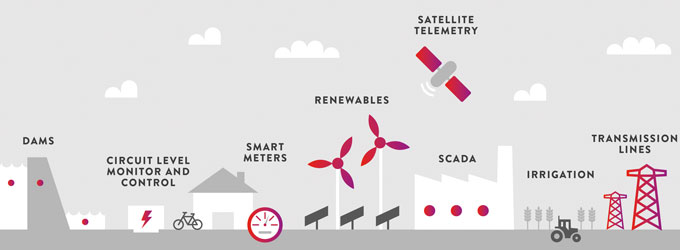
Water managers and power generators typically collect large amounts of information to help them make decisions. Organisations are also increasingly using sophisticated monitoring and communications technologies to make assets ‘visible’ around the clock and remotely, to achieve better results with less worker time, effort and travel.
However, these valuable sources of information are usually stored in disparate systems or repositories, including SCADA, telemetry, GIS, document repositories, field notes and CCTV systems. As well, these systems often predate the Internet, and, as a result, may not be easily or securely accessed, and may be confined to office or station networks.
For this asset data to yield insights and optimise operations, the different sources of information need to be unified and displayed in meaningful ways that add value to the basic data.
Managing data to maximise water flow for hydropower generation
Entura worked with its parent company Hydro Tasmania, Australia’s largest water manager and producer of renewable energy, to tackle this data challenge in relation to the canal system that brings water to Tarraleah, a hydropower station in the central highlands of Tasmania.
Managing the flow of water into the canal system is critical for maximising the available water to Tarraleah (and hence its capacity to generate valuable electricity), as well as maintaining the station’s safety and reliability.
As a canal is not a natural waterway, one might assume that keeping it running at the highest possible water level should be easy and predicable. However, the combined effects of uncontrolled inflows, automatic pumps, and unwanted plant growth in the canals make management of water levels in these canals much more complex.
Water levels can rise unexpectedly, spilling valuable water and potentially damaging infrastructure such as roadways or even the canals themselves.
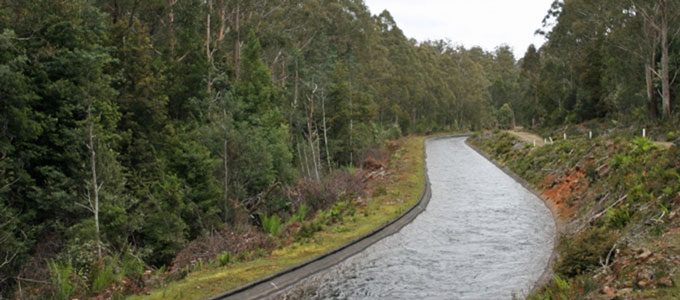
To achieve more efficient and remote management of the water flow into the Tarraleah canal system, Hydro Tasmania aimed to embrace and integrate the latest technology to monitor the live condition of the canals through SCADA, telemetry and manually read data, and make this data more readily available via a single online interface.
The first step towards this goal was understanding the existing limitations of the available information and access to data. GIS provided an excellent overview of the canal system, and was relatively straightforward to use and access via a web browser, but it did not contain any real-time or historical time series information.
The telemetry system contained some information about monitoring sites, but very little about how the data related to other aspects of the system. Also, it could only be accessed from specific computers, and required training and expert knowledge to use. The SCADA system recorded its data to an interface which provided little information about site relativity or purpose, and the interface could only be used within the power station. Some of the more valuable information about the canal system was kept by engineers in isolated document repositories.
These issues acted as barriers to understanding the canal system, hindered the ability to explain it to other people, and made it difficult to find the appropriate data for analysis.
Developing a data solution
To make Tarraleah’s canal information more useful, a data solution had to be interoperable, real-time, secure, synchronised, spatially integrated, contextualised and meaningful, and cost-effective.
| interoperable | To achieve interoperability across multiple devices and operating systems, a web-based platform provided the most suitable and cost-effective solution. A standards-based approach was used in developing the interface, so that the resulting system was able to work seamlessly across devices, with data accessible through a single user interface on laptops, tablets and smart phones. |
|
real-time
|
‘Seeing’ the status of infrastructure in real-time called for the data being displayed to be as current as possible, with each point in the chain of data transfer eliminating any unnecessary latency. Performance between the source of the data and the server was streamlined, and latency between the server and the user device was minimised through WebSockets, a new technology using highly efficient two-way binary connections to transfer data with minimal overhead. This allowed an extremely efficient flow of data (less than 500 ms). |
| secure | It was essential that the design did not introduce security risks for the sake of efficiency. To maximise efficiency and minimise security risks, all data was collected from the source and pushed over encrypted links via proxy servers to a cloud server, where it could then be pushed to the waiting client devices. The cloud provider chosen to store the data was considered one of the more secure in Australia, and one of only a few to feature the highest security certifications required by large utilities and mining companies. The software architecture used best-practice methodologies to isolate the data and keep it secure. |
| synchronised | With data stored in a variety of different systems, and ranging from real-time to historical, multiple systems required synchronisation, which was achieved via a configurable ‘data bridge’ solution using plug-in architecture. |
| spatially integrated | The system collated large amounts of spatial information, from maps or GIS or other business systems, into simple reusable formats for display. This required a versatile web-based mapping platform, with the ability to represent the canal, indicate its water level, represent and describe work orders, and link to other internal systems and information to allow easy visualisation of that item of work. |
| contextualised and meaningful (via metadata) |
With thousands of different data sources under management, the system needed to classify data so that users of the system could easily locate data relevant to their requirements. Meta tree structures were used to classify all the data, allowing hierarchical associations. Each data source was tagged with multiple different types of metadata (such as state, scheme, power station, data owner, site type, status), and grouping structures allowed nested grouping of information, such that users could filter information specific to their needs. The metadata structures could also be used to build dynamic security- sensitive dashboards of data, including any new data added to the system tagged with the appropriate information. This saves the time needed to configure dashboards, and makes sure all relevant data is available to the people that need access to it. |
| cost-effective | The system used technology that Entura had already developed to deliver similar projects for other clients, minimising the need to develop new software. The system itself is ‘cloud’-based, allowing the cost of the infrastructure to be shared among a larger group of customers. |
Simplifying access to data is helping Hydro Tasmania maximise the day-to-day operational efficiency of the Tarraleah canals, make better long-term operational decisions, and reap enhanced returns on investment. Employees now have a live view of the canals on iPads or tablets, enabling them to ‘tune’ the canals for maximum efficiency.
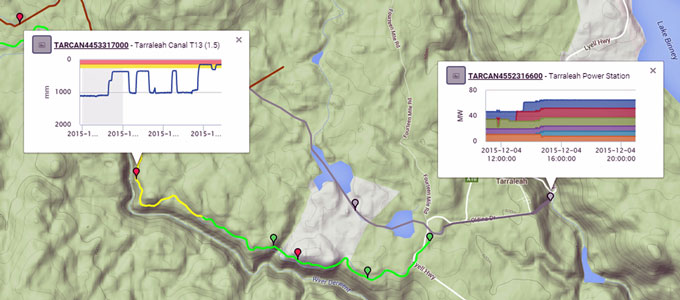
Similar solutions to those developed for this project can be used by power and water asset owners and managers to solve a range of data management challenges, including monitoring remote power stations, forecasting floods, and managing irrigation storages.
When we overcome barriers such as restrictive technologies and lack of metadata, we can make the most of our data. Interlinking multiple sources of information and displaying the results meaningfully leads to smarter decision-making and greater insights into how to operate our assets for maximum efficiency and value.
To discuss how Entura can help you manage your data to reap greater operational rewards, contact Phillip Ellerton on +61 439 010 172 or Patrick Pease.
MORE THOUGHT LEADERSHIP ARTICLES
Getting the bigger picture from your data
Like having a pile of puzzle pieces but no box, are you drowning in data but unsure what it is telling you about your power and water assets?
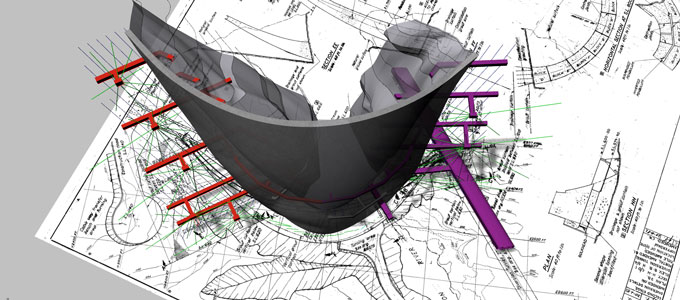
Gathering and interpreting complex data to detect emerging problems is an important aspect of asset safety worldwide. Avenues for collecting data are becoming more sophisticated and accessible and less expensive. We routinely gather data and explore data gaps, data quality and data processing, but how often do we rethink the fundamentals of presenting and communicating data?
For data to be useful, it has to help us diagnose issues and design solutions to keep our assets, our operators, and the public, safe. To do this, it must be understood. Traditionally we have used 2D methods to present data, but forming a picture of an asset from 2D information is very time consuming, often requiring site visits and hours exploring drawings, drill logs and construction photos to understand the complexities of the asset’s design and construction.
Because we have evolved in a 3D world and our senses have evolved to match, the human brain has significant and sophisticated resources dedicated to visual processing and understanding objects in three dimensions. This makes 3D models a naturally efficient medium for rapidly displaying, interpreting and communicating complex information relating to our assets.
Bringing data to life
With advances in technology, we are now able to quickly convert raw data to build 3D models from 2D drawings, and also to animate data in 3D to show change and movement over time. In 3D, assets can be quickly visualised and explored digitally from any angle. This spatial representation allows us to see important things that may otherwise be hidden, or not stand out, in the context of the overall design and layout of an asset.
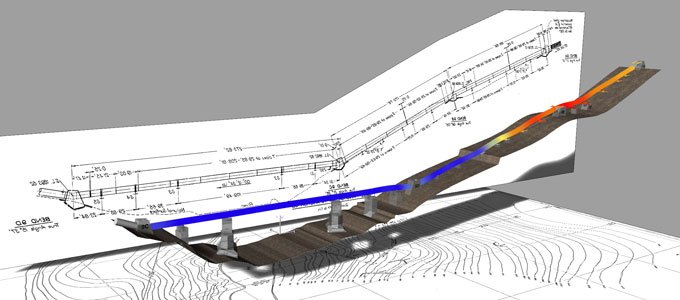
Features normally hidden can be drawn into a 3D model, such as internal layouts or features under the ground. These can all be independently switched on and off, so that elements critical to the analysis can be considered individually, or contextually against other features to get the bigger picture.
With 3D information at their fingertips – whether on desktops in the office or on smartphones or tablets in the field – engineers, data analysts or field inspectors can better understand assets in significantly less time, reducing costs, complications and misunderstandings.
Time changes everything
To understand our assets, we rarely look only at the here and now. Change is the key to identifying and preventing potential failures or problems – so we must look carefully at past and present data and continue to watch our data into the future. In the past, representing change over time could only be economically achieved in 2D because manually updating 3D models was laborious and time-consuming.
Specialist power and water consulting firm Entura has developed systems that allow data sets (from Excel, Access or other programs) to be automatically processed and displayed onscreen, producing 3D ‘snapshots’ or even animating data directly in 3D. The systems have been developed to allow quick tweaking of model parameters to show different data sets individually or in combination, to exaggerate movements where critical changes are too small to directly detect by eye, or to use colour coding to clearly represent critical parameters.
Perhaps the most significant advantage is that these models can be updated in a matter of minutes rather than days, by individuals with little or no CAD experience, simply by adding new data into the model’s database.
Should seeing always be believing?
Like any tool, 3D representations have some limitations. However, with experience and a little caution, the power of 3D representation can be fully exploited with minimal risk.
Just as 2D drawings can have mistakes or exclusions, 3D models are only as good as the data from which they are built. If incorrect drawings are used to build a model, or the wrong data is used in animations, 3D outputs will not represent the real world but may still look very convincing.
Like any engineering analysis, when 3D models are first produced, a clear review and approval process is needed, and model results must be verified against expected performance to ensure that the tool is robust and can be used reliably into the future.
The real challenges of complex assets
Entura has applied advances in 3D data modelling and presentation to support the management of a range of water and power assets including hydropower stations, water pipelines and dams.
In each of these three examples, 3D modelling delivered a comprehensive picture of system behaviour over time:
- Our use of 3D modelling to explore the movement of turbine plinths at Hydro Tasmania’s Gordon Power Station contributed to a clearer understanding of a pattern of ongoing movement. This helped to identify potential causes and inform future remedial works.
- Developing a 3D model of a steel pipeline made it much easier for an asset owner to understand and make decisions about the extent and possible causes of unwanted movement of the pipeline and its supports. Our model clearly indicated the extent of movement, leading to a targeted engineering solution that directly addressed the root cause of the problem without unnecessary investigation, over-design or delay.
- When we applied 3D modelling to a hydropower dam built on a geologically complex foundation including dissolvable limestone, the resulting model combined the dam’s foundation profiles, underlying geology and leakage rates, and animated 3D water levels in the foundation. The 3D model is helping the owner to quickly and fully understand the data and easily monitor the performance of this complex asset.
In each of these cases, new data can be quickly integrated, allowing easy ongoing monitoring and clearer communication of the current and likely future behaviour of these assets.
With a bit of caution and experience, 3D data presentation tools can offer powerful benefits to asset owners and their stakeholders, putting all the pieces of the data puzzle together to quickly and easily reveal the full picture of an asset’s condition and performance over time, supporting decision-making for cost-effective and timely maintenance and upgrades.
To discuss how Entura can help you get the full picture from your data to better understand and manage your assets, contact Phillip Ellerton on +61 439 010 172 or Shekhar Prince on +61 412 402 110.
MORE THOUGHT LEADERSHIP ARTICLES
Prioritising safety at Rouna 2 hydropower station, PNG
As the saying goes, ‘safety doesn’t happen by accident’.
The measures taken to address safety risks at the underground Rouna 2 hydropower station in Papua New Guinea offer a timely reminder of the basic requirements for adequately managing safety risks and protecting workers when upgrading older hydropower stations or when developing new ones.
The upgrade of Rouna 2 – including adequate exits, flood protection, fire and smoke detection and control, and emergency management – illustrates that much more than just the main generating equipment needs attention to adequately identify and address safety risks and hazards in a hydropower station.
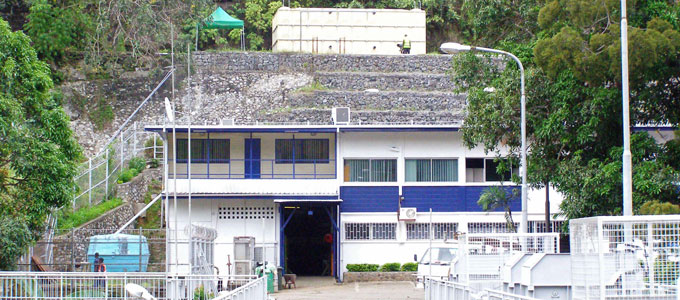
A run-down, risky hydropower station
Rouna 2 is one of four stations operating in a cascade down the Laloki River. It has five 6 MW vertical-axis hydro units from the late 1960s housed in an underground machine hall. Although only a small station, Rouna 2 has all the complexity and requirements of a much larger station.
By the time specialist power and water consulting firm Entura began working on the project to upgrade Rouna 2, the power station was old, run down by years of hard work, and was presenting its owners and workers with safety risks typical of many older hydropower stations.
The initial project concept was simply to refurbish the machines, but it quickly became clear that repairing or replacing only the generating units wasn’t going to be enough to sustain the power station’s operation, and that safety concerns needed to be urgently remedied.
Upgrading station evacuation
The Rouna 2 power station originally had only one access and exit route for the underground machine hall via open stairs in a 200 metre-deep vertical access shaft. No alternative emergency exit route was available. As the access shaft also contained all the power and control cables, it further intensified fire and safety risks.
To improve evacuation, a new emergency escape route was created via new ladders and platforms down the tailrace surge shaft to the tailrace tunnel, which normally carries water out of the power station.
Within the machine hall, the emergency escape route was made safer by being enclosed and made fire resistant, and kept smoke-free by a fan started automatically. Smoke hoods (emergency evacuation masks that reduce the risks of inhaling toxic smoke and gas) are provided to offer temporary protection for personnel needing to cover large distances to the start of the safe escape route.
To provide adequate lighting and signage for emergency escape, the DC-powered emergency lighting was upgraded. Evacuation alarms were improved, including strobe lights as well as audible sirens.
Improving flood protection
An underground power station surrounded by huge quantities of water under high pressure is particularly vulnerable to flooding. Rouna 2 had poor flood protection and dysfunctional evacuation alarm systems.
The evacuation alarms were upgraded and linked to flood detection within the machine hall. An automatic flood protection scheme was implemented to shut down the underground generating units and close the surface intake gate.
Improving fire and smoke detection and control
Hydropower stations are at risk of fire because they are full of electrical equipment. The Rouna 2 station had no fire detection system and minimal fire protection systems, so urgent attention to all fire measures was needed.
New fire panels and a new fire detection system were installed, as well as a new fire-fighting water supply, fire hydrants and hose reels. Sprinklers were installed in the access shaft and the machine hall. Older carbon-dioxide-based fire-protection systems for generator fires were replaced with water-spray systems. Fire doors were rehabilitated to close automatically.
Implementing an innovative new ventilation system
Ventilation systems in hydropower stations seldom provide any adequate smoke removal, despite the dangers of smoke inhalation. Technical innovations in the upgrade of Rouna 2’s safety systems included methods for smoke control integrated with the station’s ventilation system and its new fire panels and doors.
We upgraded the ventilation and smoke exhaust system by automatically reversing the ventilation fans during a fire, so that they exhaust smoke from the machine hall to the surface, and draw fresh air back down into the machine hall. At the same time, automatic fire doors close within the machine hall.
A safer power station for a safer future
Although new, large hydropower developments typically embrace complex and comprehensive safety standards and features, around the world many older stations are seriously deficient, presenting hazards that urgently need to be identified and resolved. Through our improvements to its ancillary services and safety systems, Rouna 2 is no longer in this extreme risk category.
However, adequate safety facilities are not the only requirement to maintain a safe hydropower station. Workers need the knowledge to maintain safety features, equipment and systems, and the skills to use them effectively. Entura has provided contract operators and station managers to work alongside local employees to help improve emergency and crisis management systems, provide local training and build capacity to ensure that Rouna 2’s future promotes a safer power station and safer workers.
To discuss how Entura can assist you with assessing hydropower station risks or developing a hydropower safety program or upgrade, please contact Shekhar Prince on +61 412 402 110.
This article was written by Ambrose Canning, Entura’s Principal Consultant, Mechanical Engineering (retired 2025).
MORE THOUGHT LEADERSHIP ARTICLES
Safer hydropower stations for safer workers
“Practices related to dam safety are well-defined and accepted throughout the world. However, hydropower safety encompasses more than just the dam … while hydropower safety is of critical importance, there is little shared knowledge on good practices around the concept of hydropower safety.” – International Hydropower Association
Hydropower stations can pose significant safety risks to those who work in them, but there is no excuse for injury or death in our workplaces. Whatever the history or location of the hydropower station, safe plant and safe work practices are critical.
Developers, owners and operators of hydro plant all need a strong commitment to workplace health and safety, and the insight and vigilance to control safety risks. As the saying goes, ‘safety doesn’t happen by accident’.
The hazards of hydropower stations
Some of the hazards at hydropower stations differ from those at thermal power stations or commercial installations. For example, hydro stations typically have limited access and no natural lighting, lower floors are often below the outside water level, and many are underground.
Hydropower hazards include fire, explosion (e.g. of pressure vessels), electrocution, flood, entanglement, slips and falls, chemicals (e.g. sulfur hexafluoride, hydrogen sulfide) and hazardous products (e.g. asbestos), and asphyxiation (e.g. carbon dioxide).
The level of risk presented by each hazard is a combination of its likelihood of occurring and the consequences if it did occur.
Seven ways to make a hydropower station a safer place
Designing safety into hydropower stations
When designing and implementing a new hydro scheme, or when upgrading an existing station, we need to carefully consider the standard of workplace health and safety to be achieved and the scope of work necessary to achieve it. This means understanding the relevant legislation, building codes and standards, and the requirements of the insurer; and being clear about the responsibilities of all the parties involved (such as the designer, developer, owner and contractors).
But while standards, codes and guides are a good starting point, the final solution needs to be tailored for the particular circumstances and level of risk. Safety systems for hydro plant can be complex and sophisticated, but they can also be as simple and robust as appropriate for the hydro facility being protected.
The primary consideration should be to provide safety facilities to get personnel out of a hydro station safely before conditions inside become dangerous. The second consideration should be providing facilities to get people out safely after conditions become dangerous. Only thirdly do we think about safety facilities to prevent damage to plant.
Planning ahead to control risks
A general approach taken to minimise workplace risks to the lowest practical level involves planning ahead for prevention of workplace accidents, injuries and illnesses, by ensuring that systems of work are safe, equipment is safe and properly maintained, and employees receive health and safety information and training and are properly supervised.
This approach is usually expressed through a ‘hierarchy of controls’:
Safety upgrades for older hydropower stations
Typically, new hydro stations are well designed and comply with appropriate safety standards and local building codes. Larger hydro stations can have safety systems as complex and thorough as those in modern multi-floor commercial buildings. However, older hydro installations were often designed with little regard to safety, and now need urgent attention to comply with modern workplace health and safety standards.
While safety facilities are readily incorporated into new hydropower schemes, they may be more difficult to retro-fit into existing schemes. The scope of work will need to take into account the interfaces with existing facilities and the tailoring required to suit the specific site and location.
Sharing our hydropower safety insights
Entura is part of Hydro Tasmania, Australia’s largest producer of renewable energy and manager of more than 30 hydropower stations with an enviable safety record. As a specialist power and water consulting firm, we’ve applied this real-world experience of designing safe hydropower stations and upgrading older plants to meet modern safety standards as we work with clients all over the world to improve the safety of their assets.
In our experience, these four very important aspects of hydropower safety should be considered as a first step towards building good practice for designing and operating safer hydropower stations:
| Station evacuation | Whatever the nature of the crisis, people must be able to get out of a hydropower station safely. All stations should have at least two independent ways to exit. If one route becomes inaccessible, an alternative emergency escape route should always be available. Adequate lighting is essential for emergency escapes. |
| Flood protection |
Hydropower stations can and do flood. Failure of drainage pumps can lead to a slow increase in the water level and eventual flooding of the station. Alternatively, a plant failure and leakage that drainage pumps cannot manage can cause rapid flooding of the station. This makes high-water-level alarms, flood alarms and evacuation alarms a necessity for life safety. Flood protection schemes can be implemented to automatically close intake gates or hilltop valves and keep turbines operating to attempt to drain the headworks and penstocks of water to control flooding, and to automatically stop hydro plant before the water levels become critical. |
| Fire and smoke control |
For life safety, we need to detect fires as early as possible, prevent them from spreading, alert all personnel, and provide safe and well-lit means of evacuation as soon as possible. Smoke control and ventilation are also extremely important. Fire will rapidly fill a hydro station with thick, black, acrid smoke, which is often a far greater hazard to personnel than the fire itself, as it obscures vision (preventing occupants from finding safe escape routes, as well as hindering search and rescue operations). It can also asphyxiate or poison people well before the temperature of the fire or smoke causes injury. A holistic fire protection system needs to attend to the full range of passive measures (e.g. fire-rated construction materials and methods), active measures (e.g. sprinklers, venting, fire-fighting equipment) and operational measures (e.g. plans, systems and training for fire prevention and response). |
| Emergency and crisis and management |
Safety at hydro stations involves more than simply having the correct equipment or hardware present at the site. It involves an ongoing commitment by the owner, management, operator and employees to provide and maintain a safe and healthy work environment. This commitment should be documented in writing and form part of a workplace health and safety policy supported by safe work systems and documentation. These should include a written risk control program and fire protection program, hazard register, site induction procedures, attendance boards, permit to work systems, local safety teams, and a detailed crisis and emergency plan. |
To discuss how Entura can assist you with assessing hydropower station risks or developing a hydropower safety program, please Shekhar Prince on +61 412 402 110.
This article was written by Ambrose Canning, Entura’s Principal Consultant, Mechanical Engineering (retired 2025).

